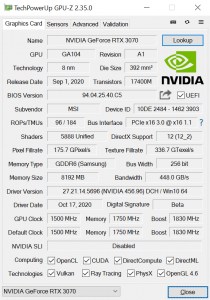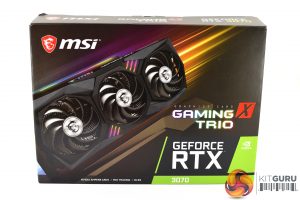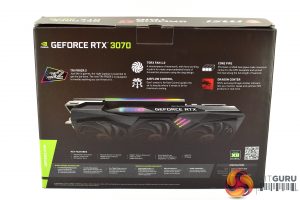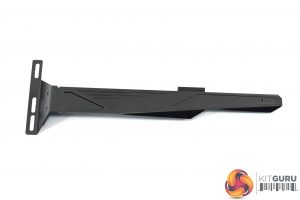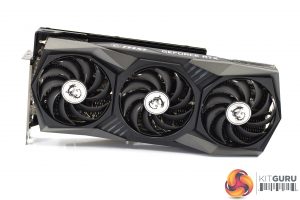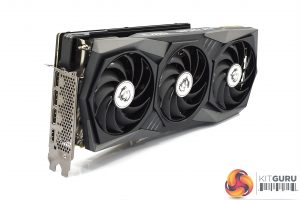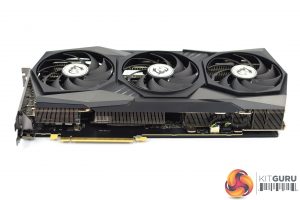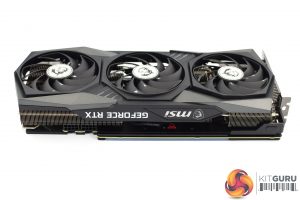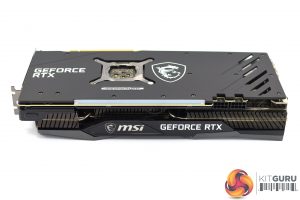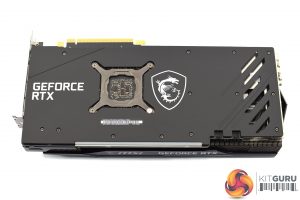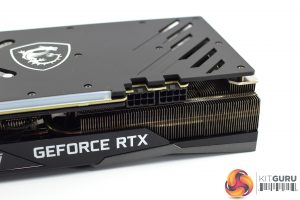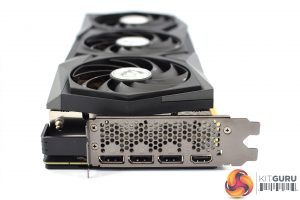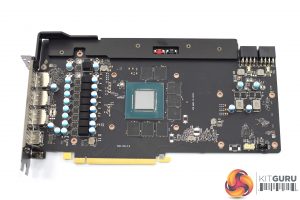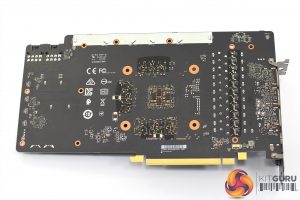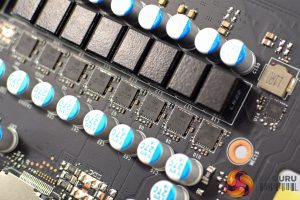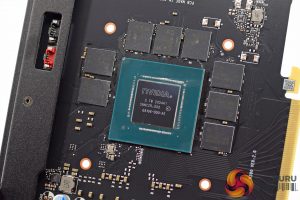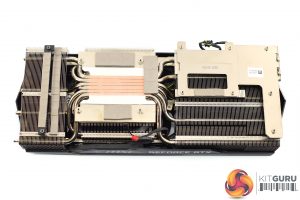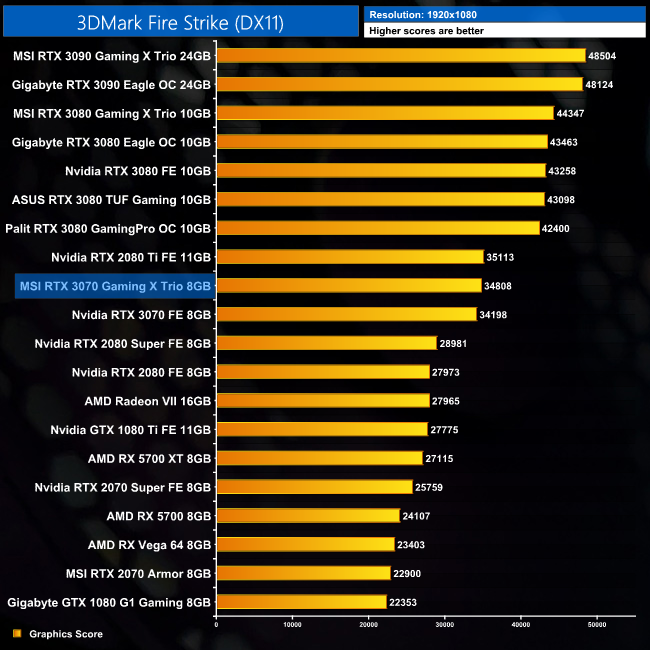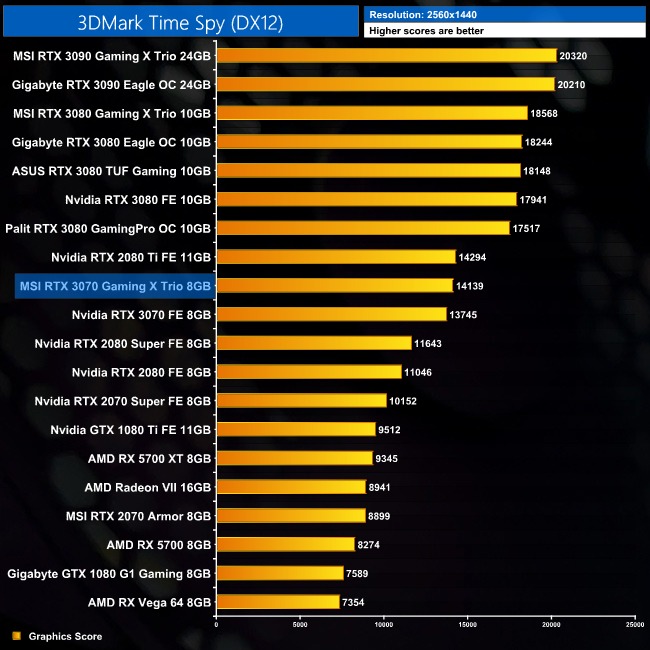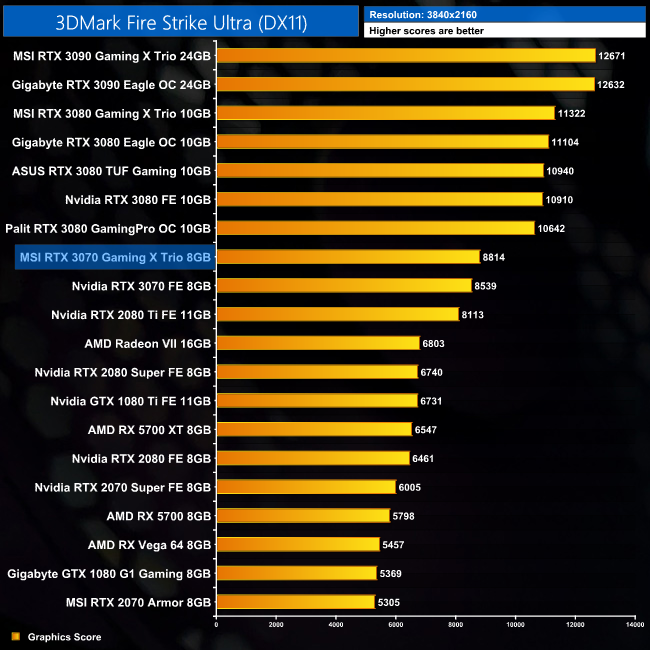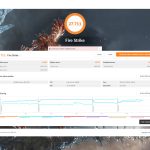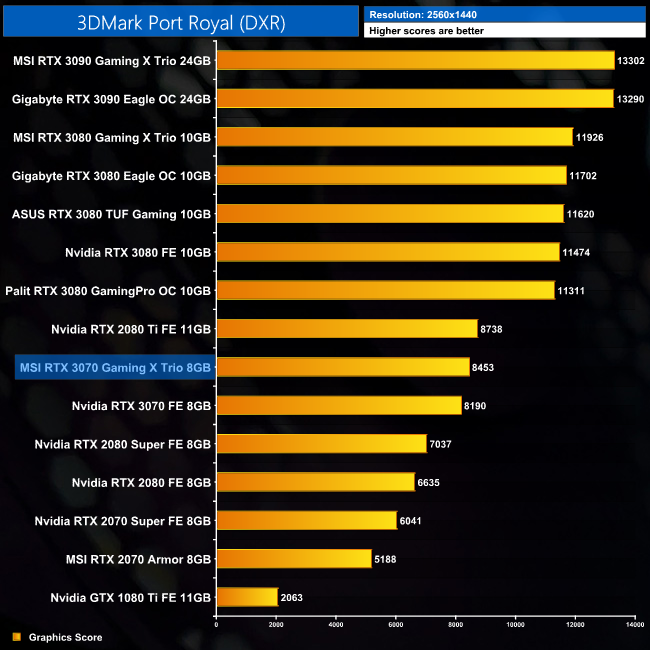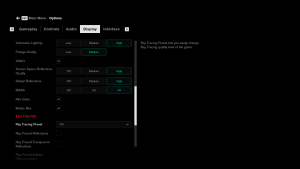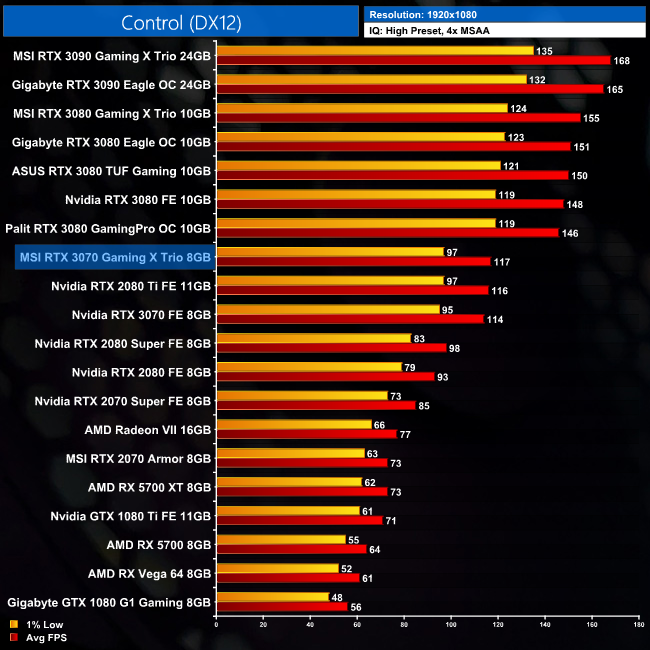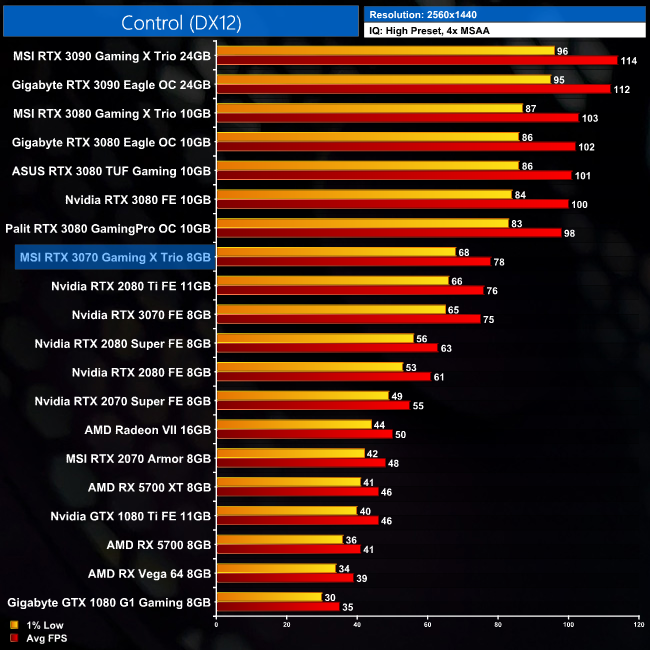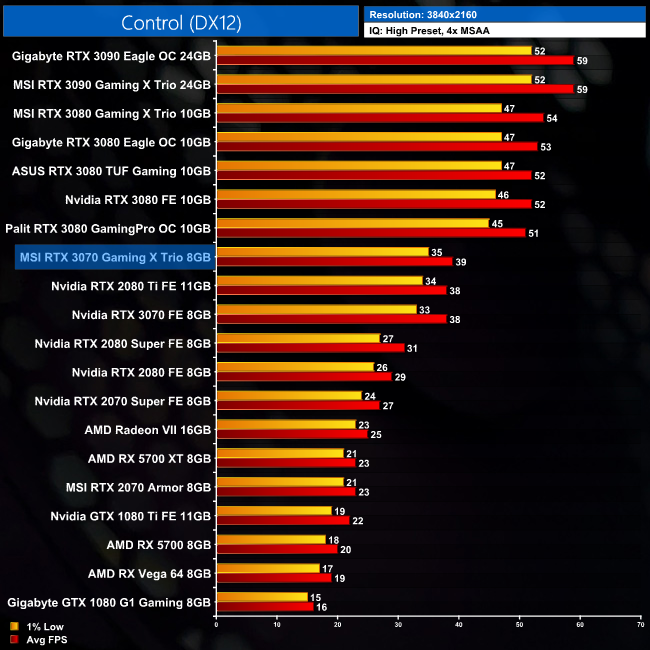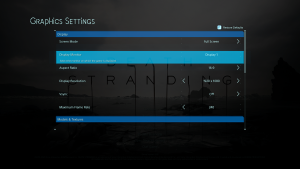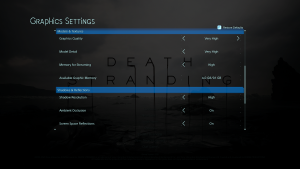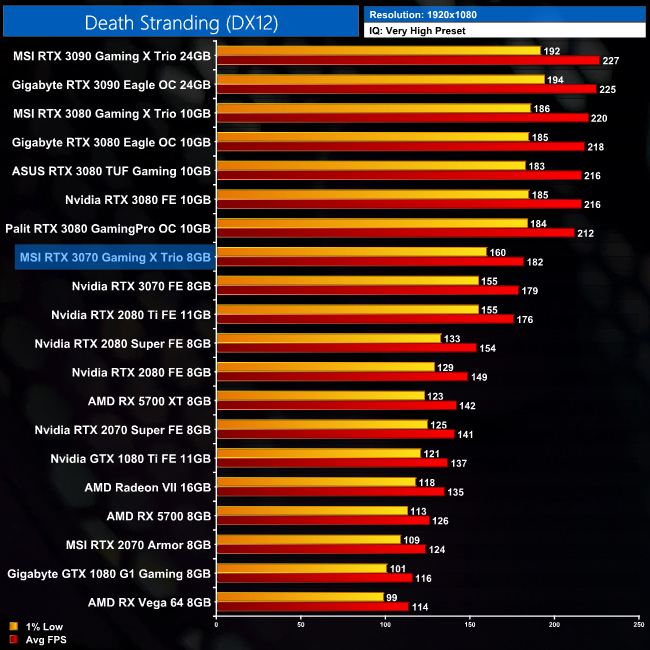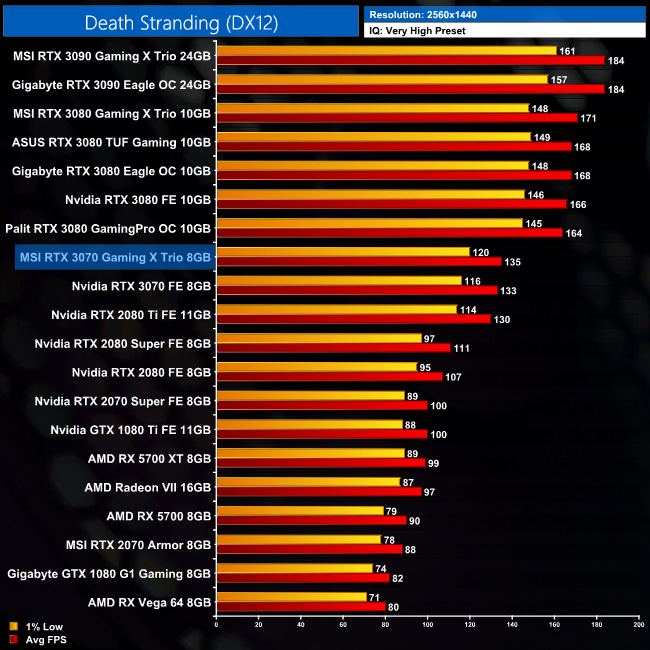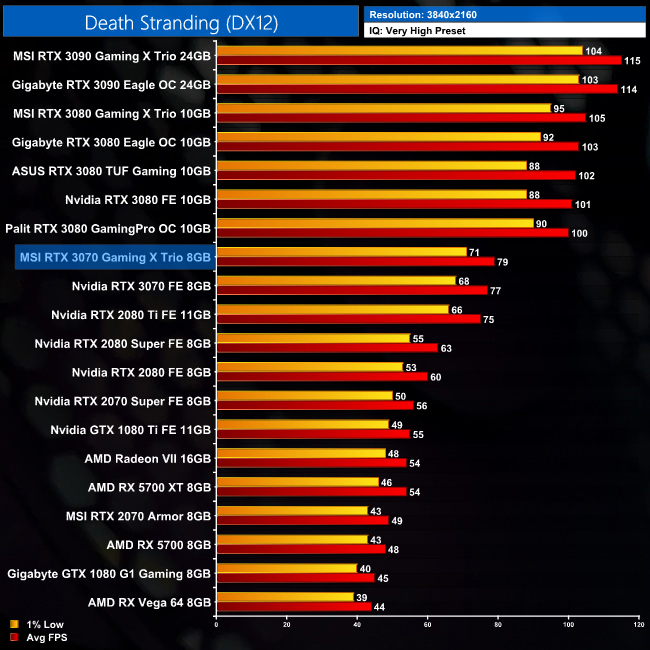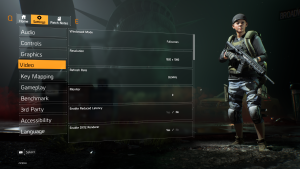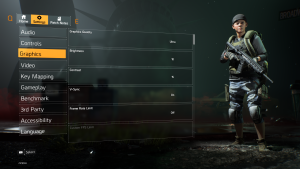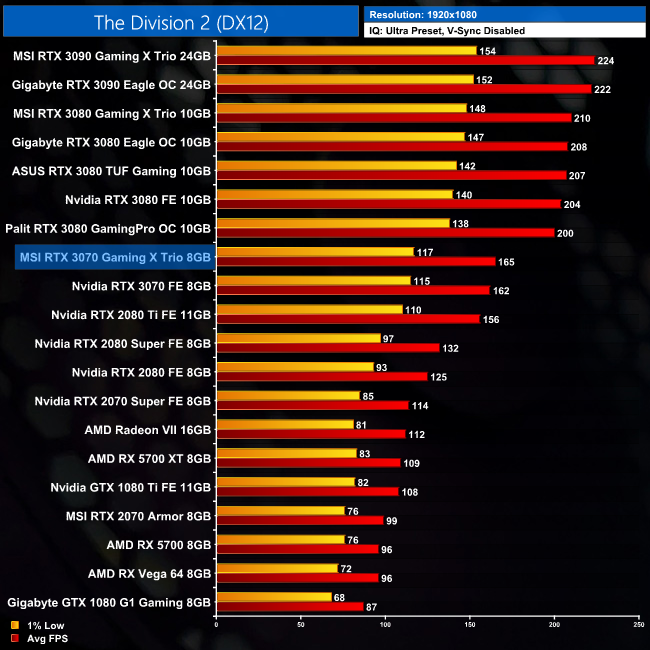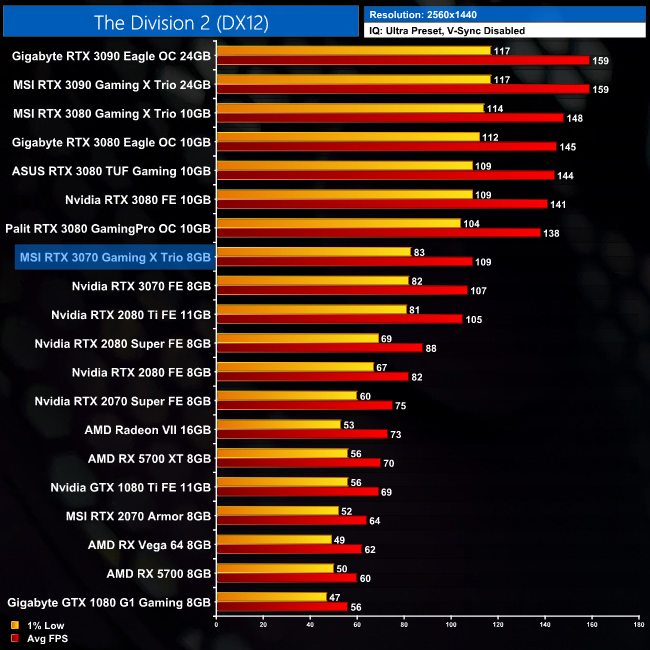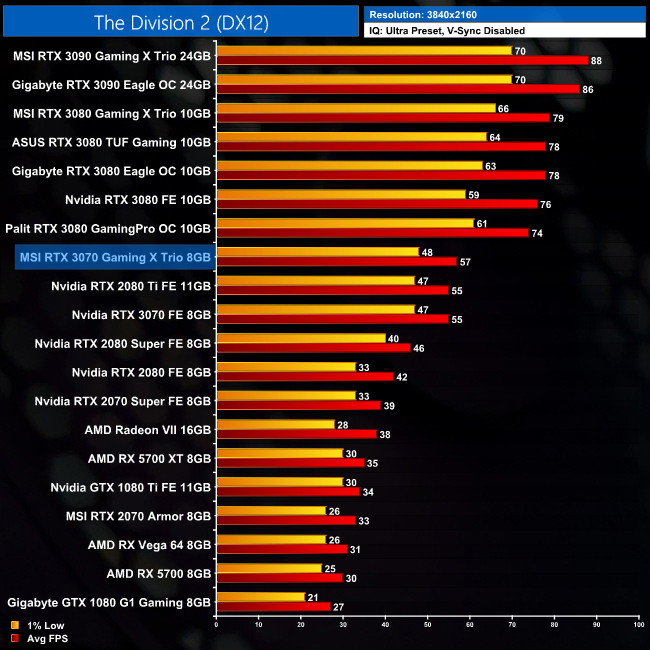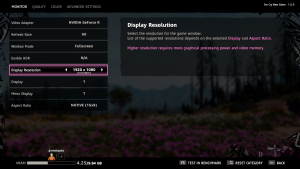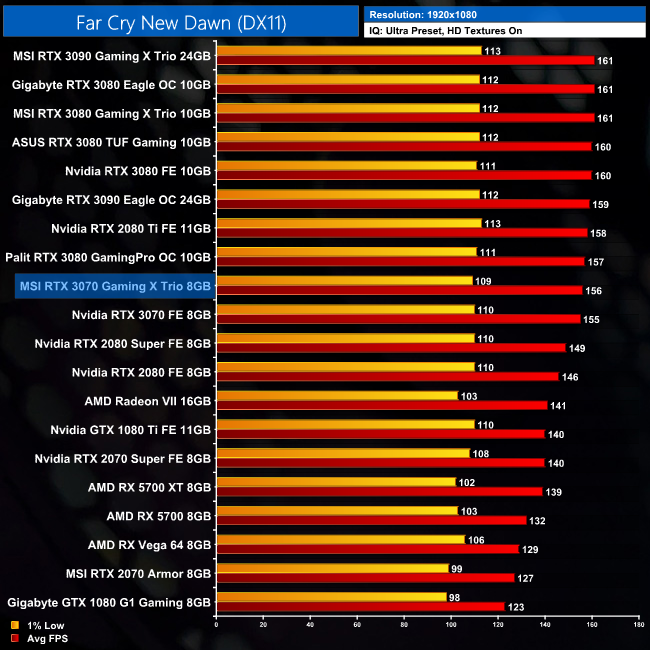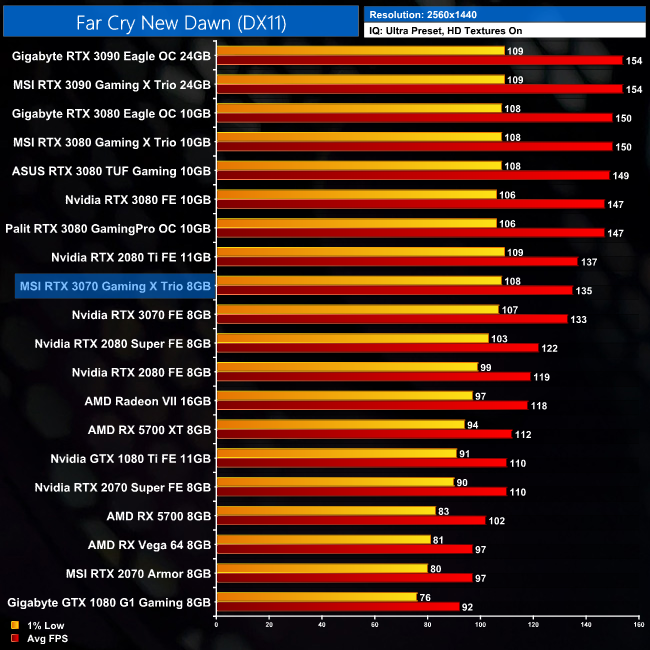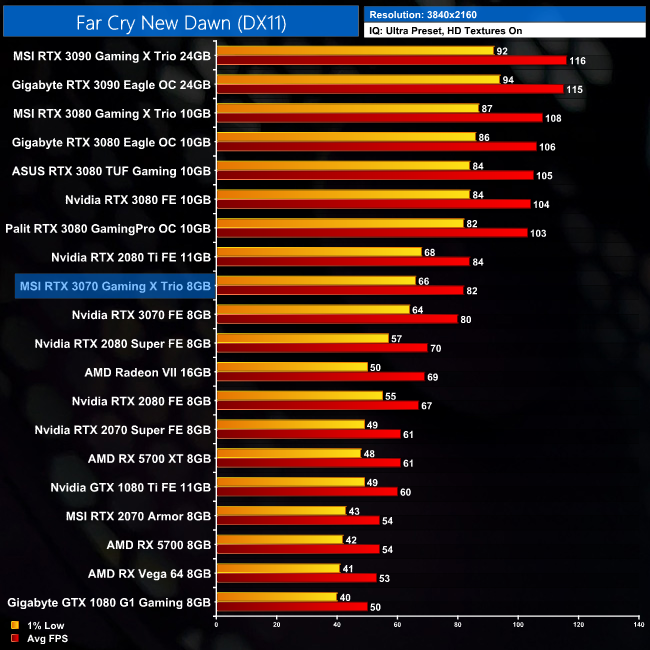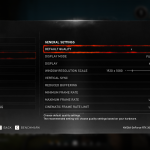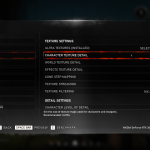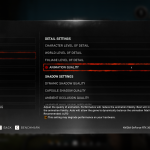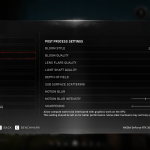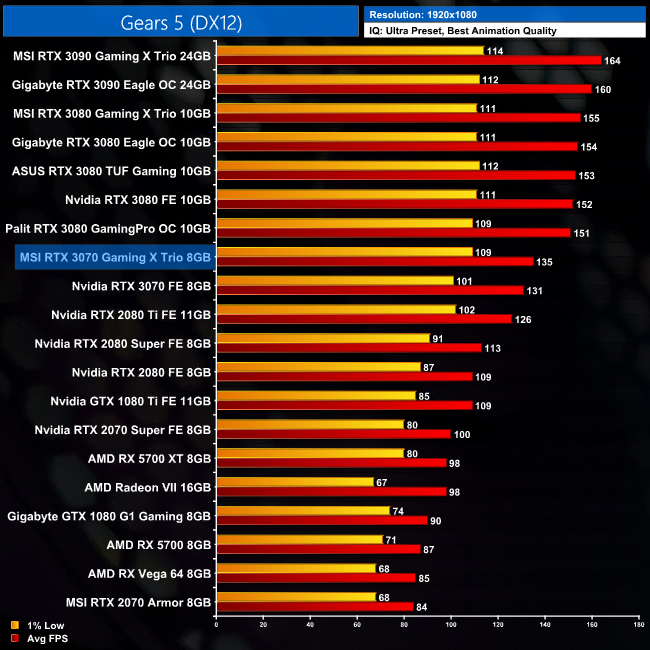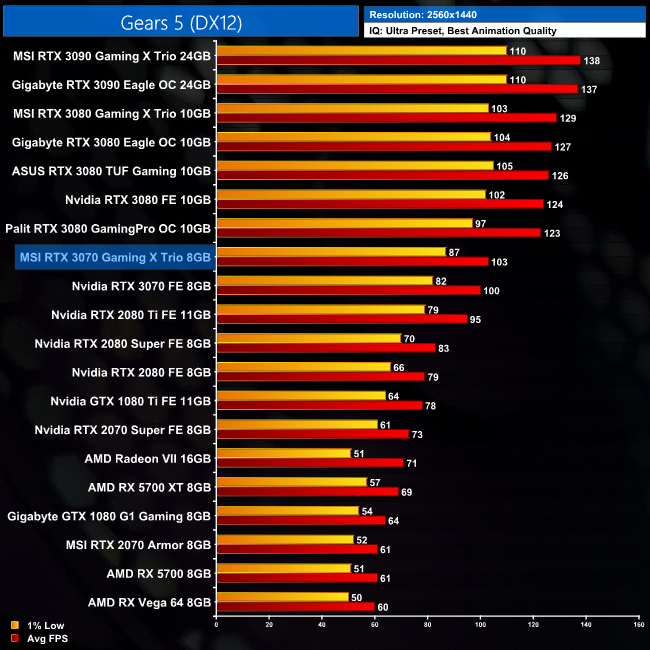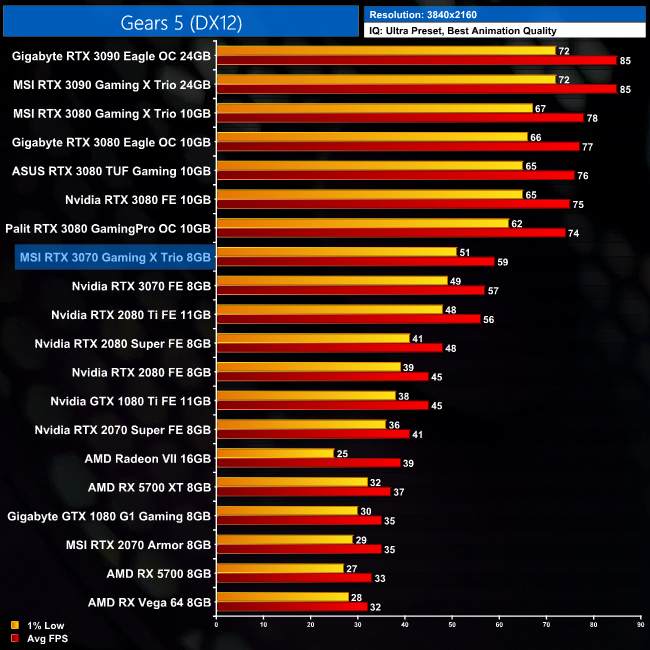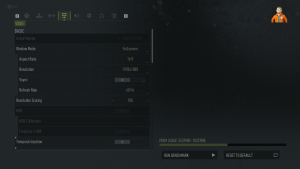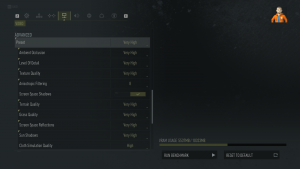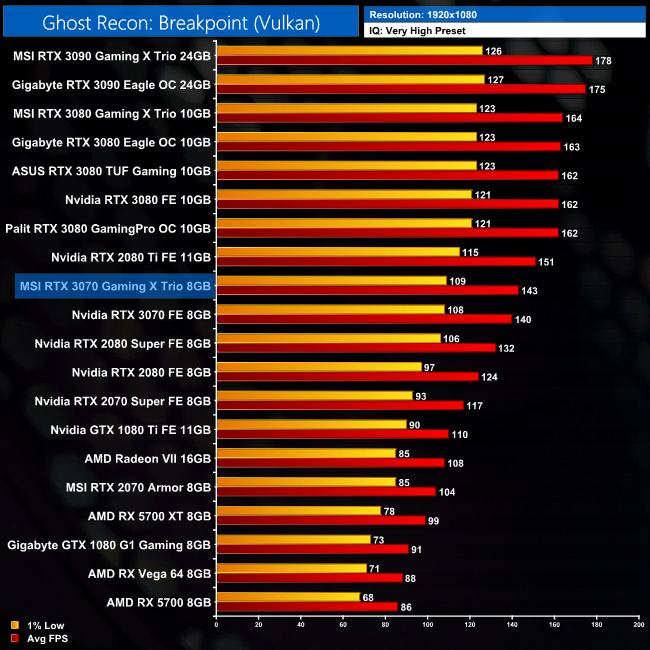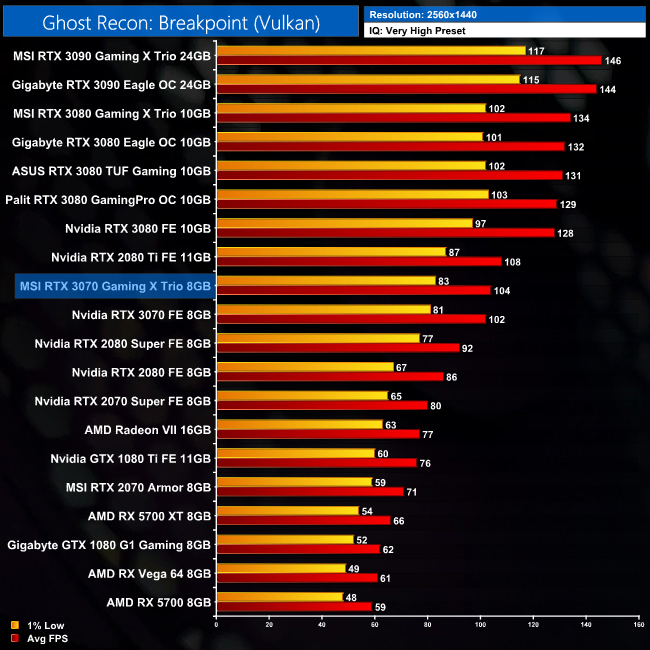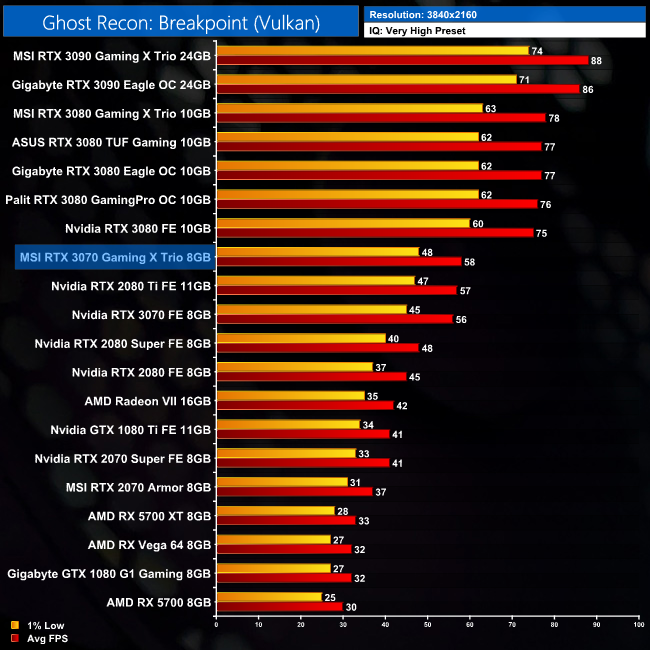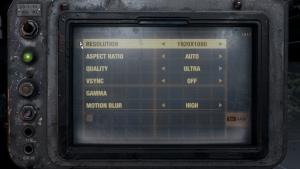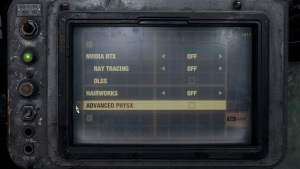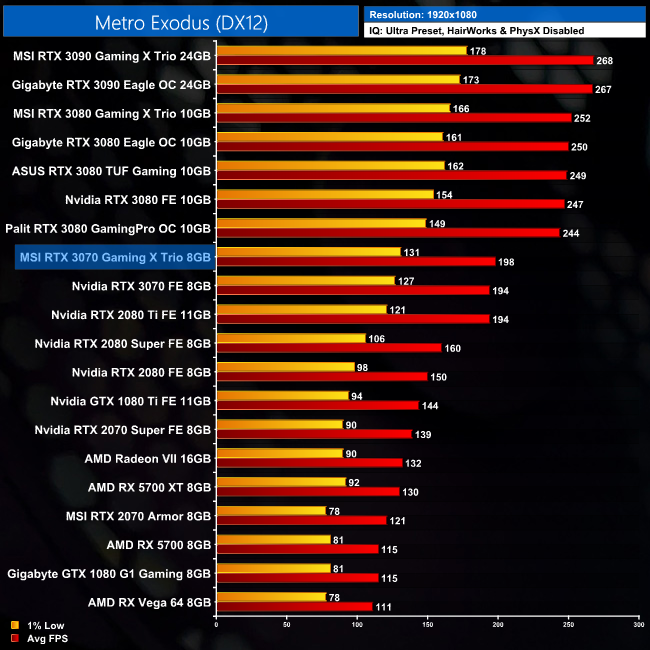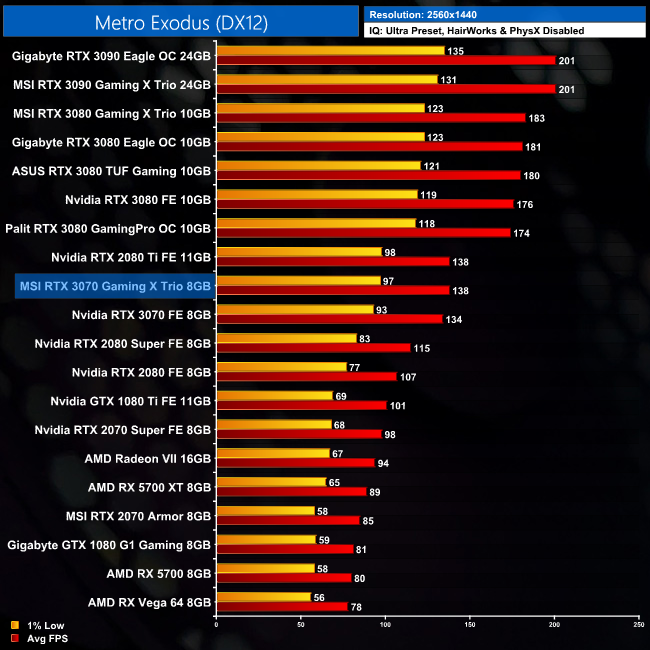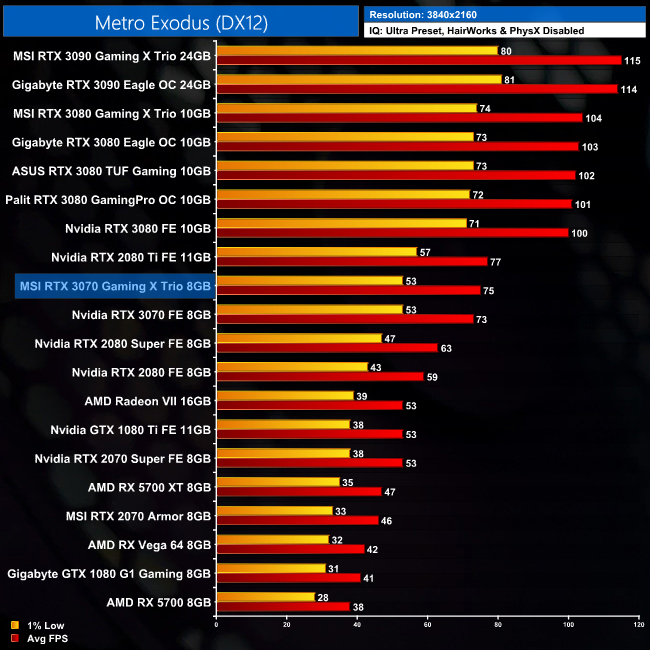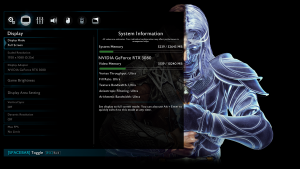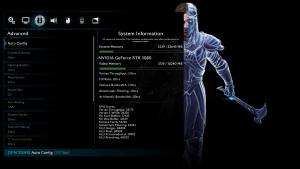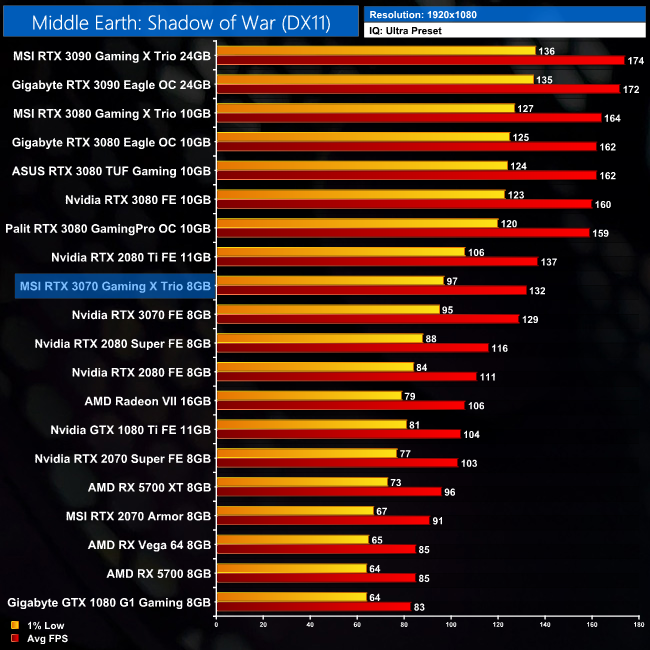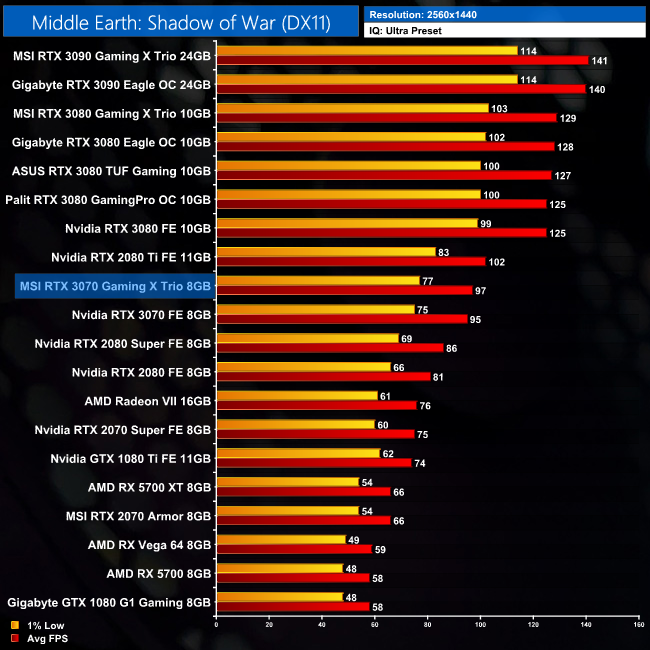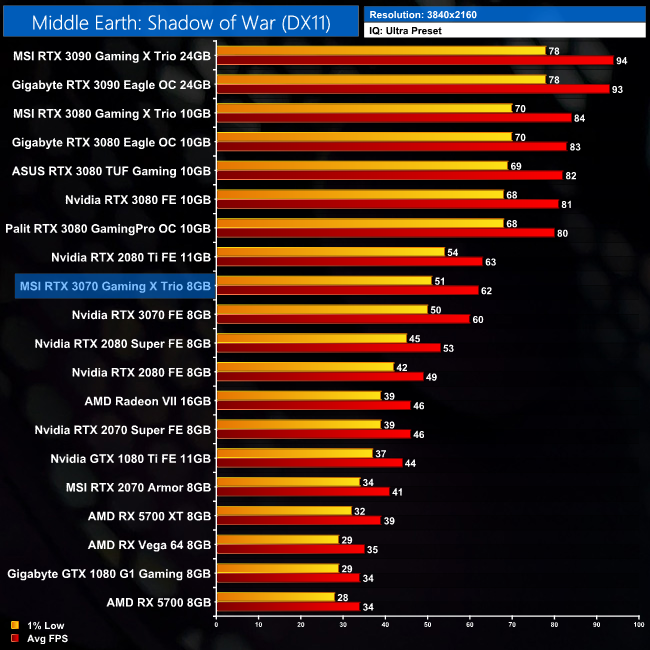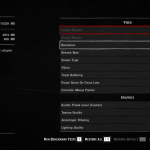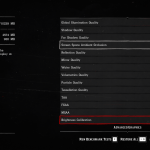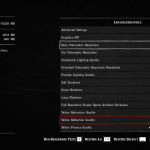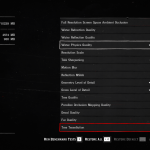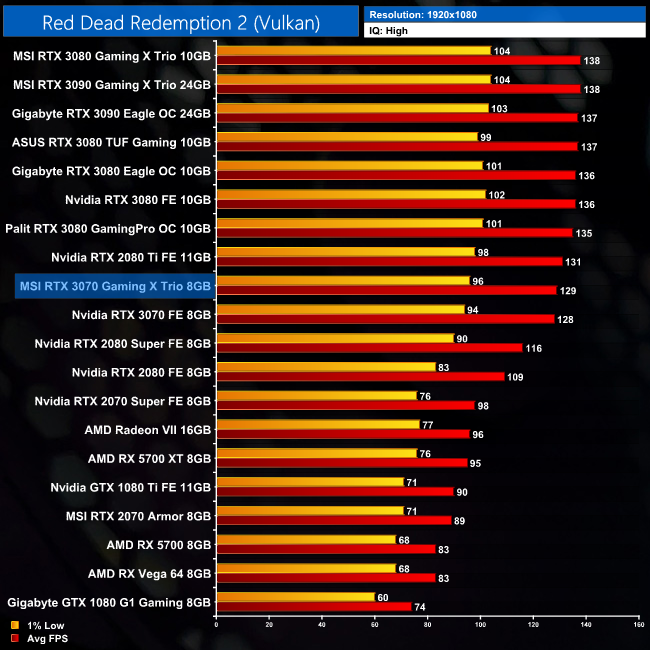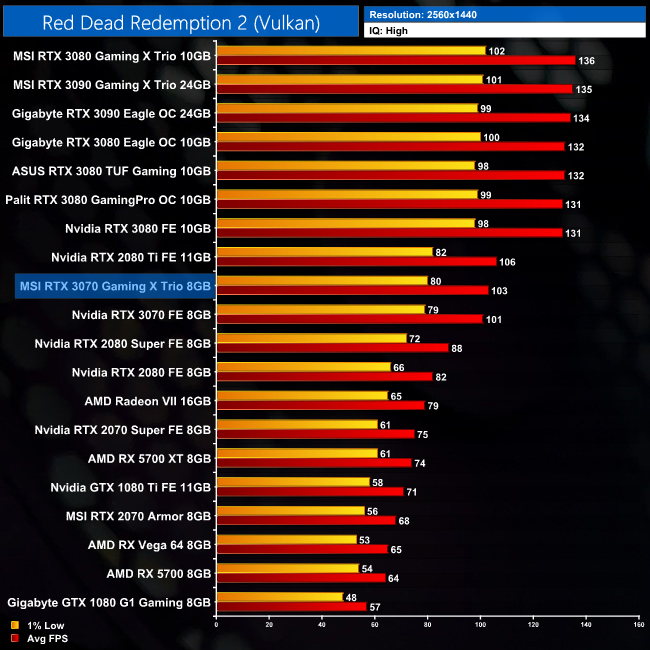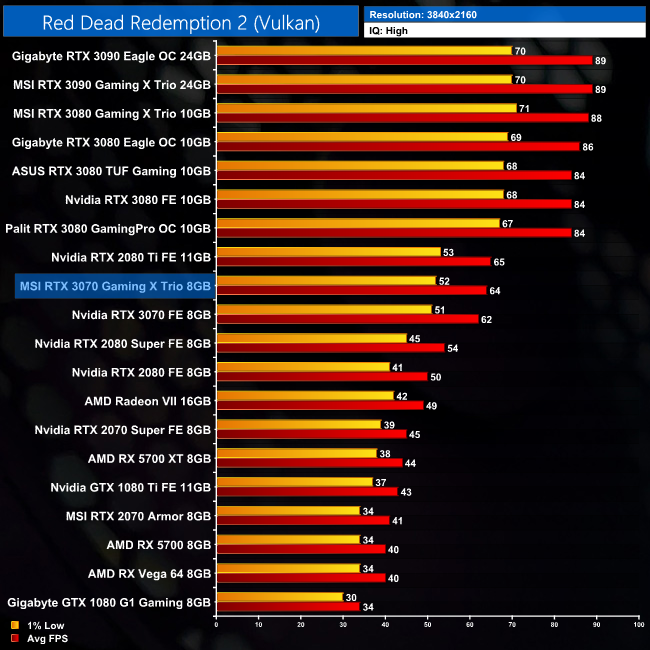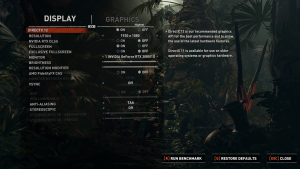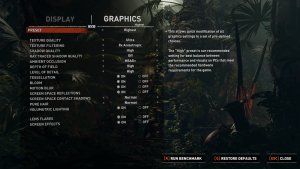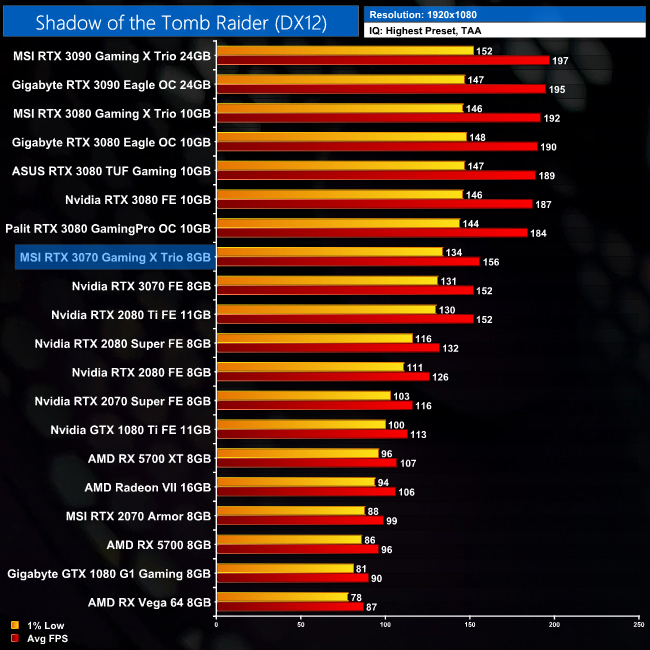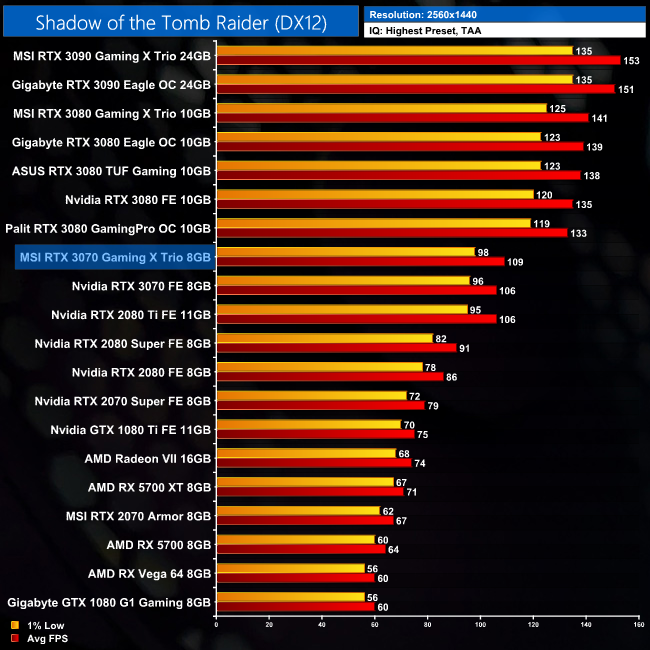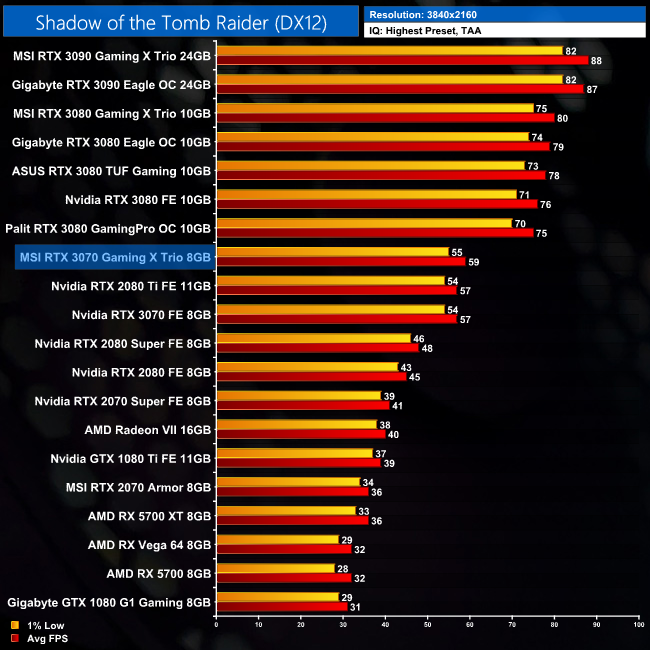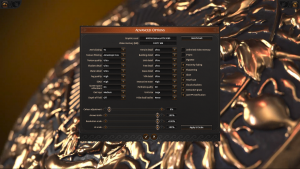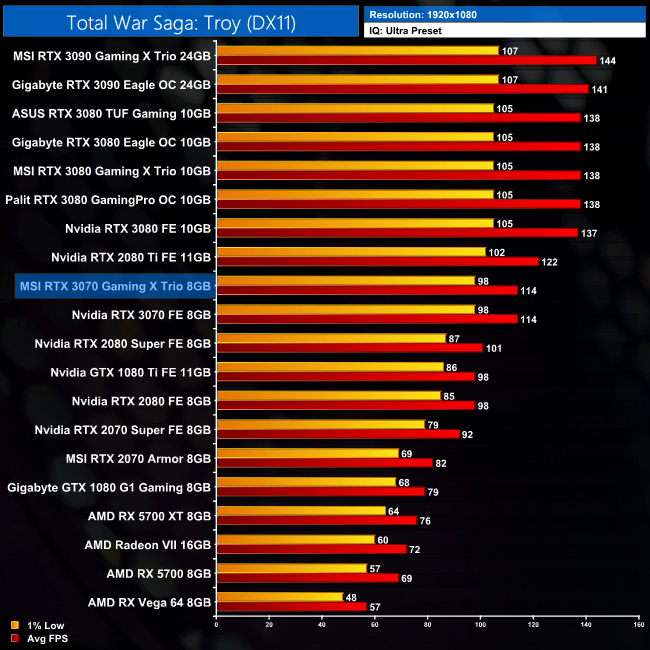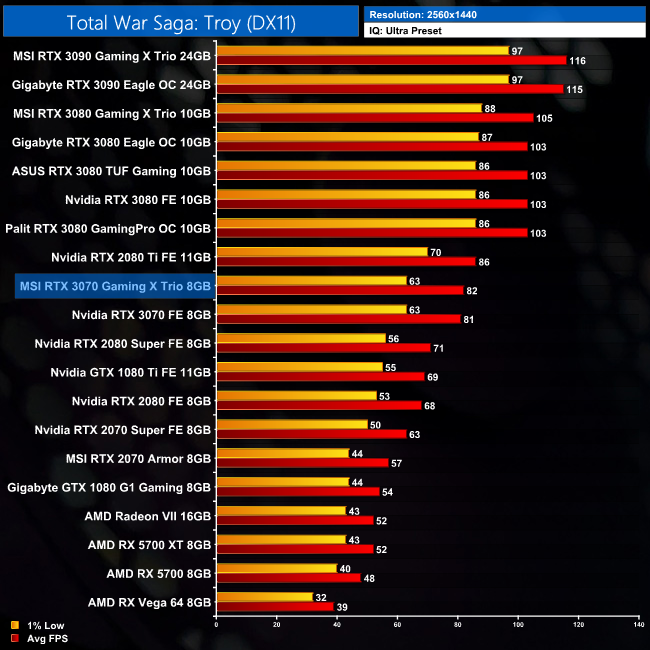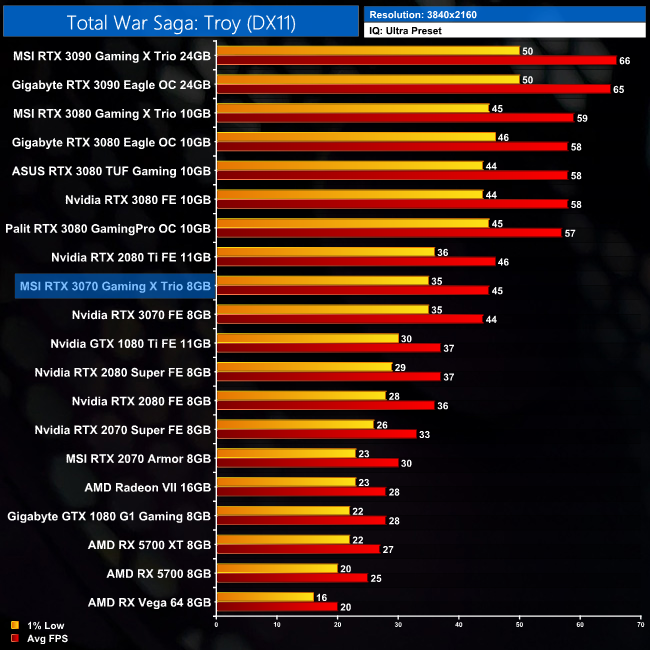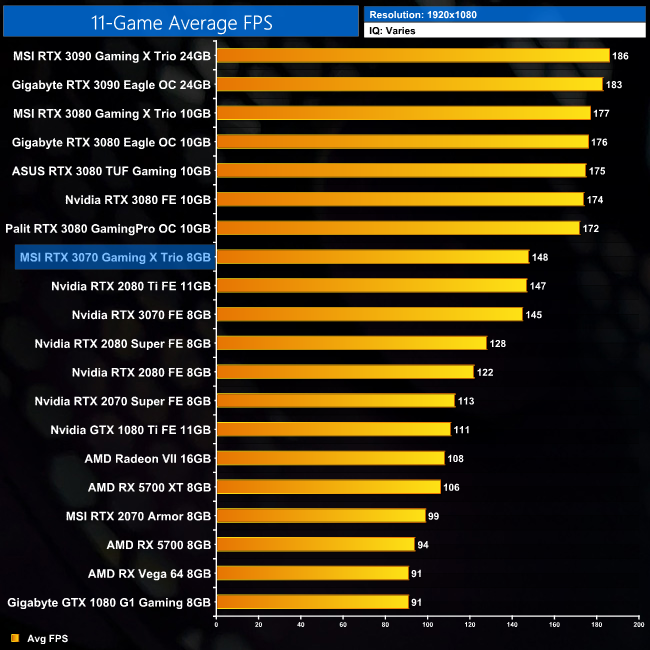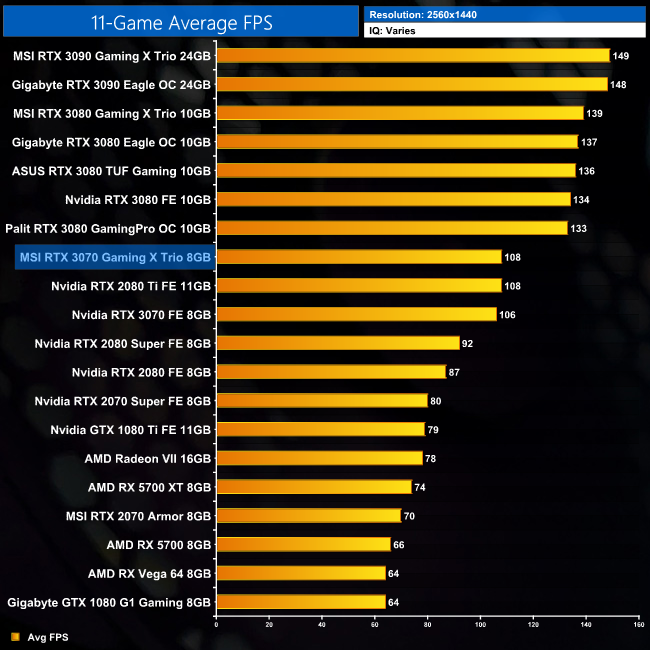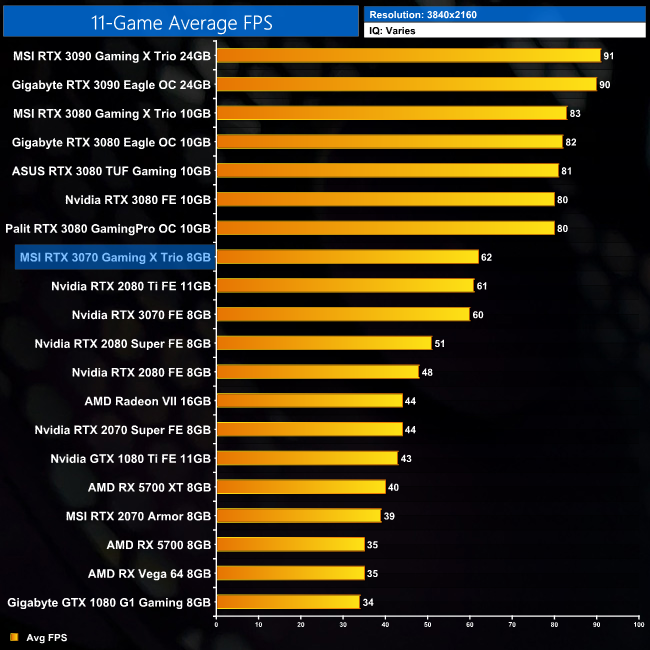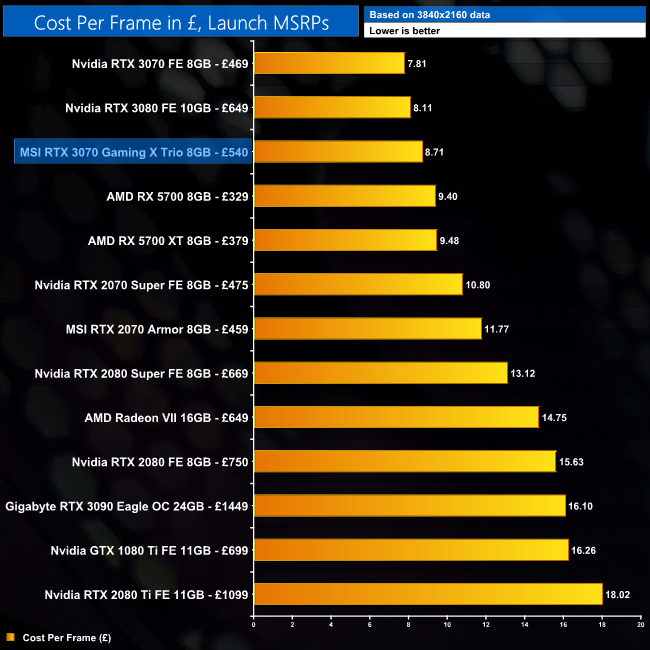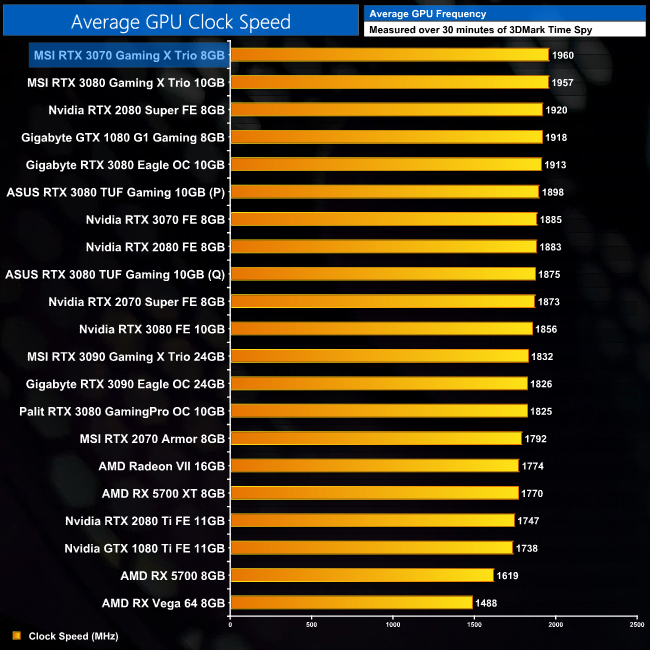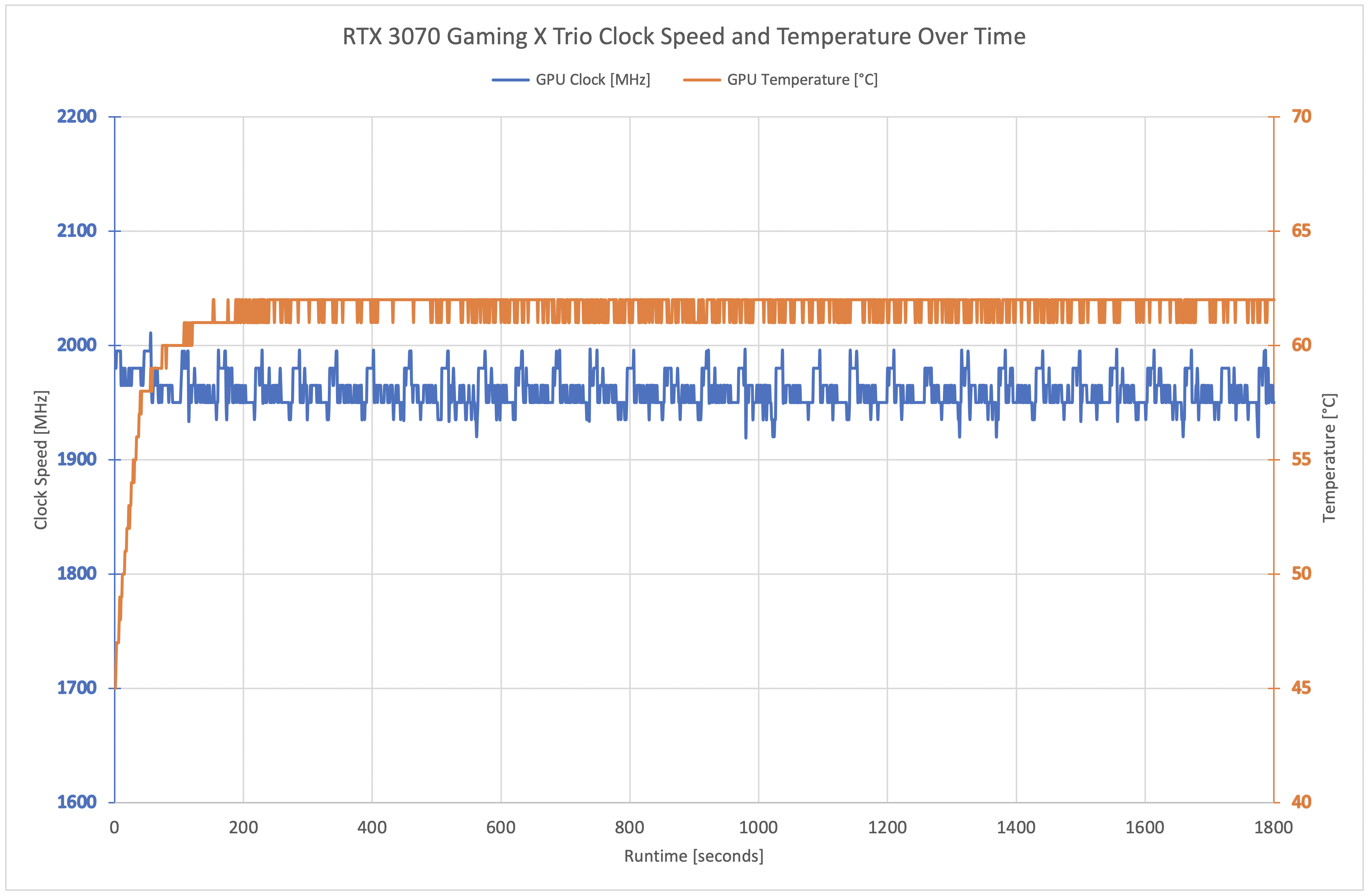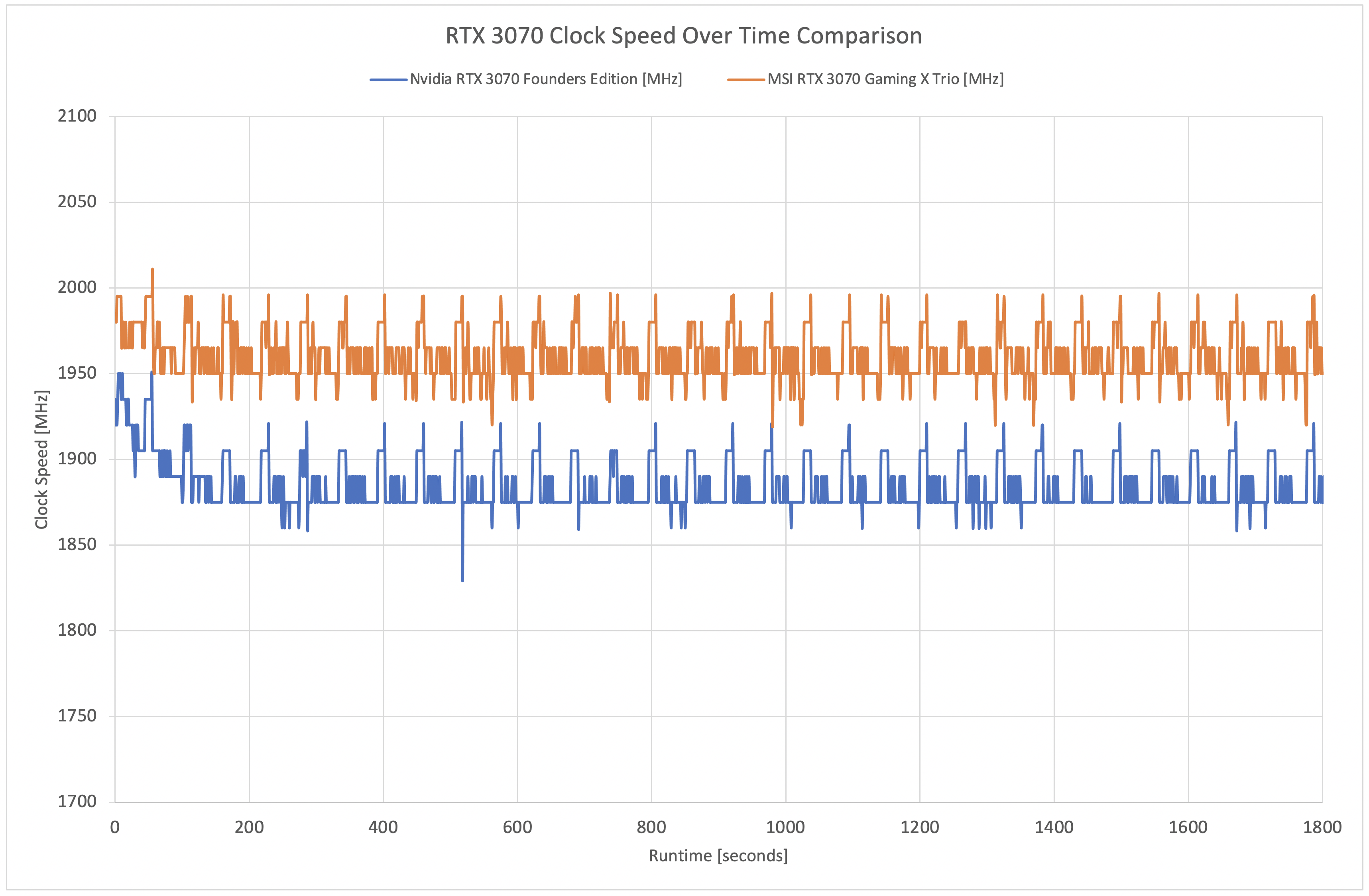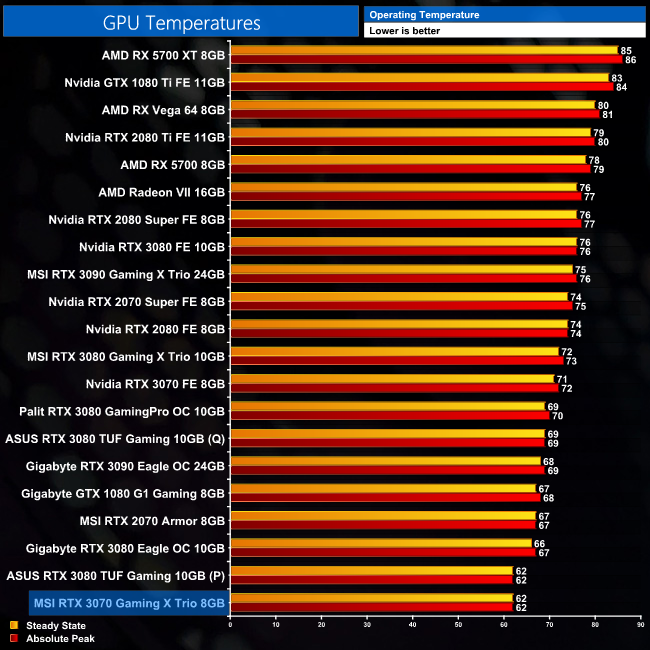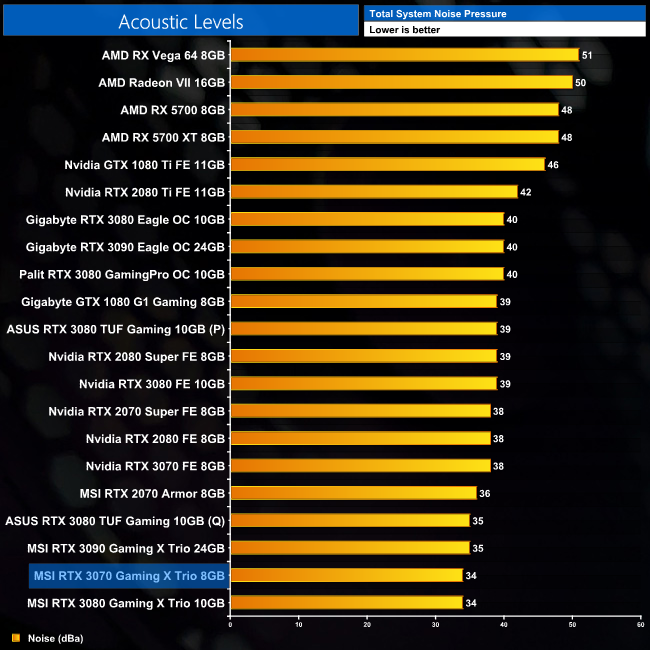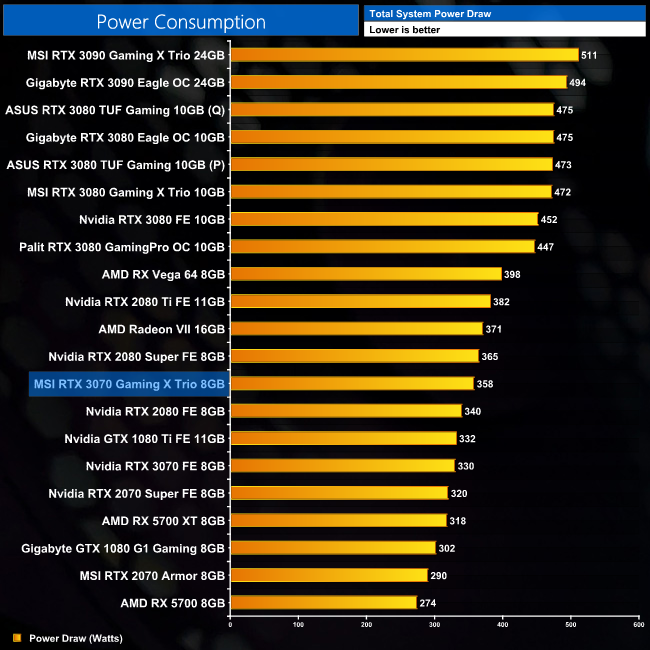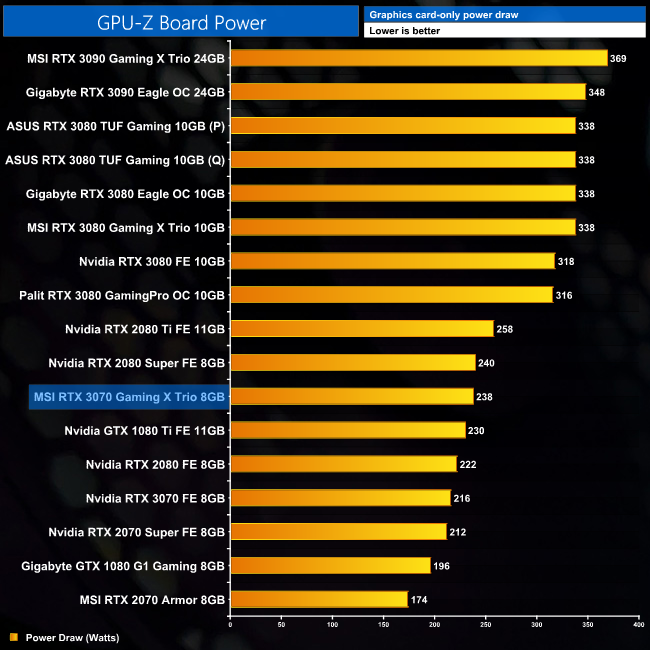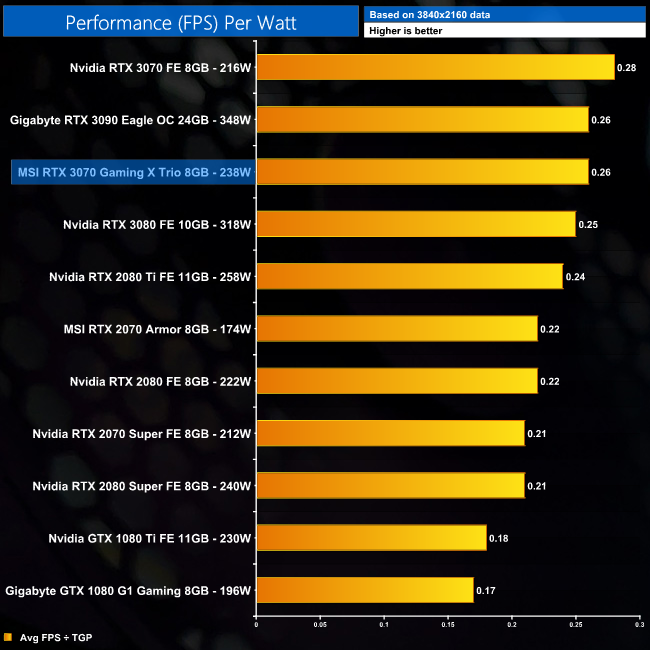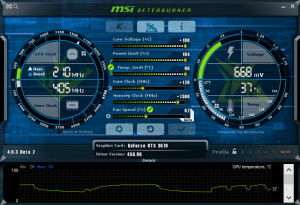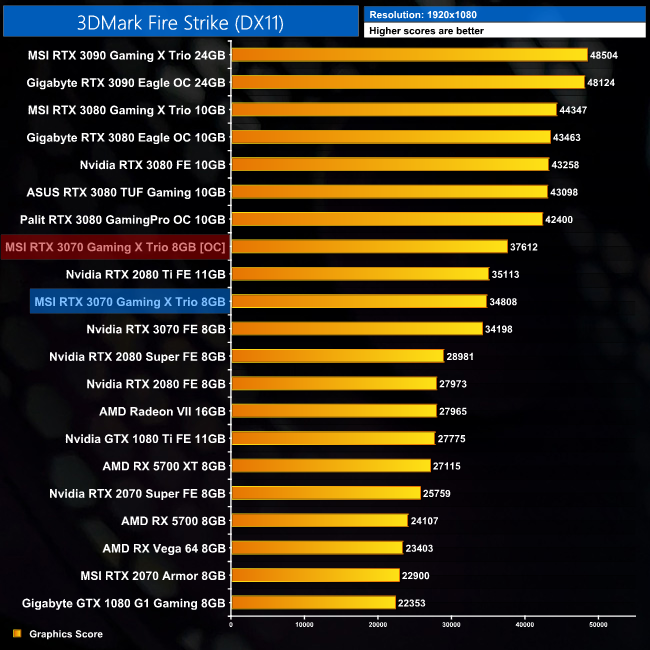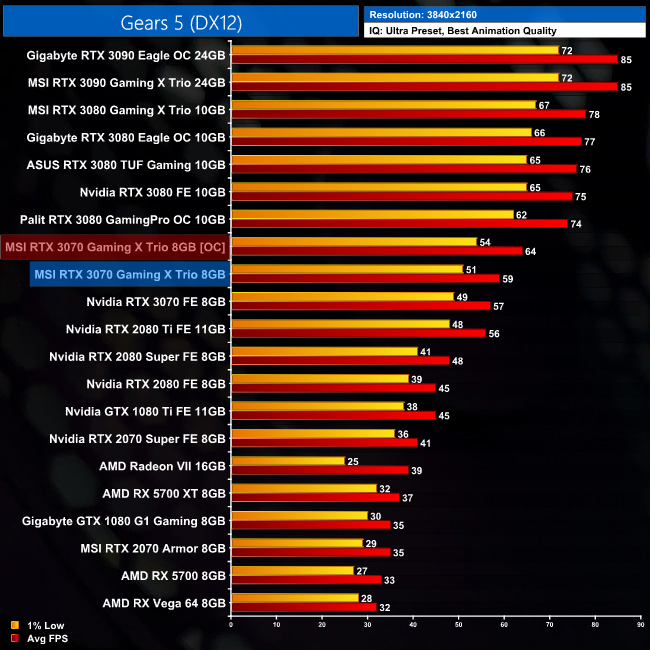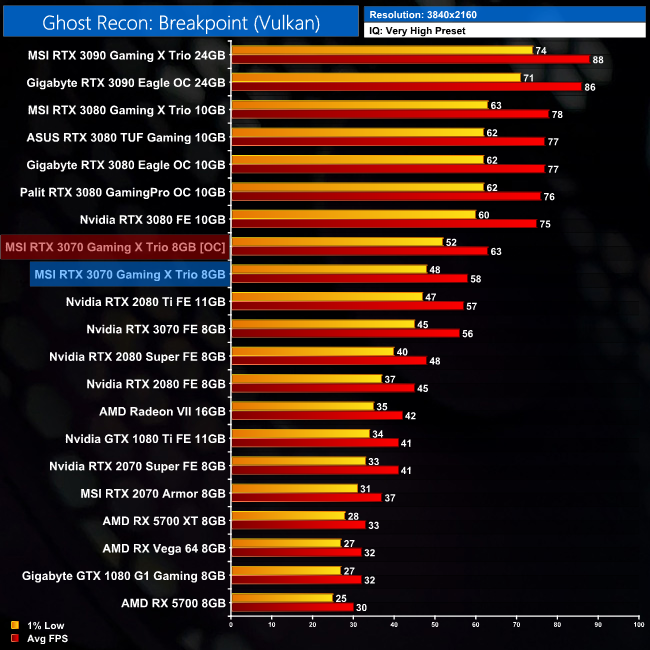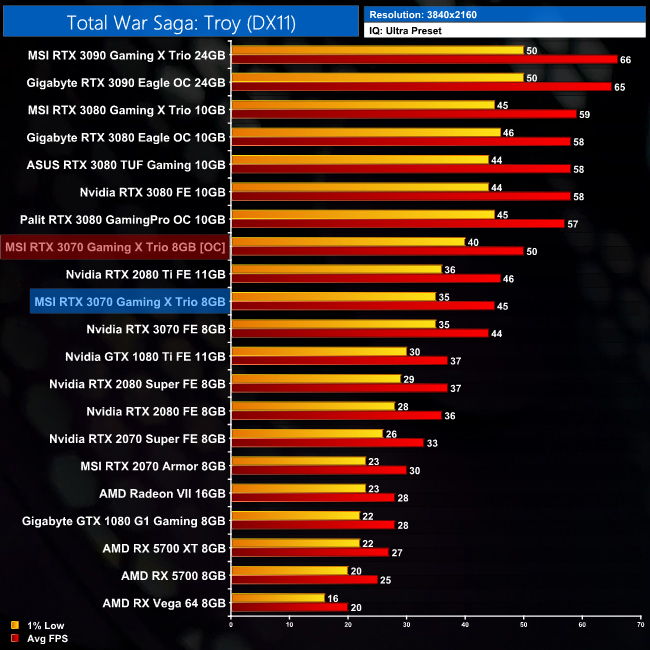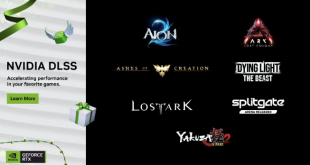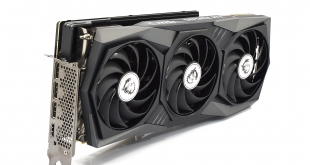
After the launch of Nvidia's RTX 3070 Founders Edition earlier this week, today we take a look at our first custom model. The MSI RTX 3070 Gaming X Trio has an MSRP of £539.99 here in the UK and comes with an increased power limit compared to Nvidia's reference design, alongside a factory overclocked core and a simply huge cooler. We put this card through its paces and see how it compares to Nvidia's dinky Founders Edition.
At first glance, you would be forgiven for thinking this is actually one of MSI's RTX 3080 or RTX 3090 designs. That's because the RTX 3070 Gaming X Trio is undboutedly a huge card, and it appears to be re-using the same shroud design as its bigger brothers, though the internal heatsink and cooler layout is a little different.
While this graphics card may not have the same diminutive appearance as the Founders Edition then, we would hope the significantly larger cooler will do a better job at keeping the GPU cool, while also reducing noise levels. We put that hypothesis to the test today.
| GPU | RTX 3090 | RTX 3080 | RTX 3070 | RTX 2080 Ti (FE) | RTX 2080 SUPER |
| SMs | 82 | 68 | 46 | 68 | 48 |
| CUDA Cores | 10496 | 8704 | 5888 | 4352 | 3072 |
| Tensor Cores | 328 | 272 | 184 | 544 | 384 |
| RT Cores | 82 | 68 | 46 | 68 | 48 |
| Texture Units | 328 | 272 | 184 | 272 | 192 |
| ROPs | 112 | 96 | 96 | 88 | 64 |
| GPU Boost Clock | 1695 MHz | 1710 MHz | 1725 MHz | 1635 MHz | 1815 MHz |
| Memory Data Rate | 19.5 Gbps | 19 Gbps | 14 Gbps | 14 Gbps | 15.5 Gbps |
| Total Video Memory | 24GB GDDR6X | 10GB GDDR6X | 8GB GDDR6 | 11GB GDDR6 | 8GB GDDR6 |
| Memory Interface | 384-bit | 320-bit | 256-bit | 352-bit | 256-bit |
| Memory Bandwidth | 936 GB/Sec | 760 GB/Sec | 448 GB/Sec | 616 GB/sec | 496.1 GB/sec |
| TGP | 350W | 320W | 220W | 260W | 250W |
To recap its core spec, unlike its more expensive RTX 30-series brethren, the RTX 3070 uses Nvidia’s GA104 GPU, instead of GA102. This implementation of GA104 incorporates 46 Streaming Multiprocessors (SMs), and thanks to Ampere’s new SM structure with its two FP32 datapaths, each SM houses 128 CUDA cores, giving RTX 3070 a total of 5888.
Ampere also places one RT core, and four Tensor cores, in each SM, giving a total of 46 RT cores and 184 Tensor cores. This is accompanied by 184 texture units, and 96 ROPs which are now housed directly within each graphics processing cluster (GPC), with 16 ROPs per GPC, and 6 GPCs in total for RTX 3070.
Clock speed is slightly higher than the RTX 3080. Where the RTX 3070 Founders Edition has a reference clock of 1725MHz, MSI has pushed this to 1830MHz boost. The power limit has also increased from 220W up to 240W.
Lastly, for the memory, RTX 3070 has ditched GDDR6X and we are back to 8GB of 14Gbps GDDR6 memory, operating over a 256-bit bus, for total memory bandwidth of 448 GB/Sec.
MSI's RTX 3070 Gaming X Trio ships in a large box, with an image of the graphics card visible on the front.
On the back, MSI highlights some key features, including the Tri Frozr 2 cooler, Torx 4.0 fans and Dragon Center software.
Inside we find a thank you note, quick user guide and a ‘how to upgrade your PC' cartoon. There's also a large metal bracket designed to support the graphics card once it is installed in your system, to reduce any GPU sag.
Taking a look at the card itself… yep, it's the same design as the RTX 3080 Gaming X Trio. That means we have a black and grey plastic shroud, with a pretty edgy and aggressive ‘gamer-y' appearance. Personally I quite like it, but that is of course going to be subjective. At the very least, it is completely colour neutral so you won't have any issues installing this in a colour coordinated system.
The three fans also use MSI's new Torx 4.0 design. Each measures approximately 90mm across, and the fan blades now come in pairs, with an outer section that directly attaches the two blades together. MSI says this ‘focuses airflow into the updated TRI FROZR 2 cooling system’, delivering 20% increased pressure compared to Torx 3.0.
In terms of the overall size of the card, it measures 323 x 140 x 56mm. These dimensions are identical to the RTX 3080 Gaming X Trio, and means the graphics card is about 80mm longer than the Founders Edition.
For the backplate, we see the return of the ‘graphene composite' backplate that was also used for the RTX 3080 model. Credit to W1zzard from TechPowerUp who noted this appears to be ‘plastic with coated graphite', rather than a fully graphite backplate. I would definitely prefer a full-length metal backplate here – the above design certainly looks good, but the thermal properties wouldn't match up to a proper metal plate as demonstrated by MSI's own RTX 3090 Gaming X Trio…
We can also note 2x 8-pin power connectors, and then for display outputs there are 3x DisplayPort 1.4a and 1x HDMI 2.1.
Once we get into the PCB, there's a few things to note. First of all, we have a 9-phase VRM for the GPU, using ONSemi NCP302045 stages which are rated for 45A average current and peaks of up to 75A. Those stages are driven by an ONSemi NCP81610, which is a maximum 8-phase PWM controller, so it looks like MSI is using power stage teaming as we cannot identify any PWM phase doublers onboard.
The memory is driven by a UPI uS5650Q controller with high and low-side dual N-Channel MOSFETs used. The GDDR6 memory modules are from Samsung, and these are specified to run at 14Gbps, while we can also note the GA104 GPU, which looks pretty small with a die size of 392 mm².
As for the cooler, here things deviate from the RTX 3080 Gaming X Trio's cooler. Instead of 6x 6mm heatpipes and one 8mm heatpipe, the RTX 3070 loses the 8mm pipe and so uses 6x 6mm pipes. Instead of two larger finstacks, there’s now 3 slightly smaller ones. Those nickel-plated copper heatipes still make direct contact with the GPU die, but there’s no extra plate to contact with the memory, which previously sat on top of the central GPU mounting area.
Driver Notes
- All Nvidia GPUs (except RTX 3000) were benchmarked with the 452.06 driver.
- RTX 3070 was benchmarked with the 456.96 driver supplied to press.
- RTX 3080 was benchmarked with the 456.16 driver supplied to press.
- RTX 3090 was benchmarked with 456.38 public driver.
- All AMD GPUs were benchmarked with the Adrenalin 20.8.2 driver.
Test System
We test using the a custom built system from PCSpecialist, based on Intel's latest Comet Lake-S platform. You can read more about it over HERE, and configure your own system from PCSpecialist HERE.
| CPU |
Intel Core i9-10900K
Overclocked to 5.1GHz on all cores |
| Motherboard |
ASUS ROG Maximus XII Hero Wi-Fi
|
| Memory |
Corsair Vengeance DDR4 3600MHz (4 X 8GB)
CL 18-22-22-42
|
| Graphics Card |
Varies
|
| System Drive |
500GB Samsung 970 Evo Plus M.2
|
| Games Drive | 2TB Samsung 860 QVO 2.5″ SSD |
| Chassis | Fractal Meshify S2 Blackout Tempered Glass |
| CPU Cooler |
Corsair H115i RGB Platinum Hydro Series
|
| Power Supply |
Corsair 1200W HX Series Modular 80 Plus Platinum
|
| Operating System |
Windows 10 2004
|
Comparison Graphics Cards List
- Gigabyte RTX 3090 Eagle OC 24GB
- MSI RTX 3090 Gaming X Trio 24GB
- ASUS TUF Gaming RTX 3080 OC 10GB
- Gigabyte RTX 3080 Eagle OC 10GB
- MSI RTX 3080 Gaming X Trio 10GB
- Palit RTX 3080 GamingPro OC 10GB
- Nvidia RTX 3080 FE 10GB
- Nvidia RTX 3070 FE 8GB
- Nvidia RTX 2080 Ti FE 11GB
- Nvidia RTX 2080 Super FE 8GB
- Nvidia RTX 2080 FE 8GB
- Nvidia RTX 2070 Super FE 8GB
- MSI RTX 2070 Armor 8GB
- Nvidia GTX 1080 Ti FE 11GB
- Gigabyte GTX 1080 G1 Gaming 8GB
- AMD Radeon VII 16GB
- AMD RX 5700 XT 8GB
- AMD RX 5700 8GB
- AMD RX Vega 64 8GB
Software and Games List
- 3DMark Fire Strike & Fire Strike Ultra (DX11 Synthetic)
- 3DMark Time Spy (DX12 Synthetic)
- 3DMark Port Royal (DXR Synthetic)
- Control (DX12)
- Death Stranding (DX12)
- The Division 2 (DX12)
- Far Cry New Dawn (DX11)
- Gears 5 (DX12)
- Ghost Recon: Breakpoint (Vulkan)
- Metro: Exodus (DX12)
- Middle Earth: Shadow of War (DX11)
- Red Dead Redemption 2 (Vulkan)
- Shadow of the Tomb Raider (DX12)
- Total War Saga: Troy (DX11)
We run each benchmark/game three times, and present mean averages in our graphs. We use OCAT to measure average frame rates as well as 1% low values across our three runs.
3DMark Fire Strike is a showcase DirectX 11 benchmark designed for today’s high-performance gaming PCs. It is our [FutureMark’s] most ambitious and technical benchmark ever, featuring real-time graphics rendered with detail and complexity far beyond what is found in other benchmarks and games today.
Kicking off with 3DMark, here we can see the RTX 3070 Gaming X Trio comes in 2% faster than the Founders Edition in Fire Strike, before increasing its lead to 3% in Time Spy and Fire Strike Ultra.
3DMark Port Royal is the world’s first dedicated real-time ray tracing benchmark for gamers. You can use Port Royal to test and compare the real-time ray tracing performance of any graphics card that supports Microsoft DirectX Raytracing. As well as benchmarking performance, 3DMark Port Royal provides a realistic and practical example of what to expect from ray tracing in upcoming games.
In Port Royal, 3DMark's ray tracing benchmark, the MSI RTX 3070 takes a 3% lead over the Founders Edition.
Control is an action-adventure video game developed by Remedy Entertainment and published by 505 Games. Control was released on 27 August 2019 for Microsoft Windows, PlayStation 4, and Xbox One. (Wikipedia).
Engine: Northlight Engine. We test using the High preset, with 4x MSAA, DX12 API.
When looking at Remedy's Control, here the MSI RTX 3070 Gaming X Trio takes a 3FPS – or 4% – lead over the Nvidia Founders Edition at 1440p.
Death Stranding is an action game developed by Kojima Productions. It is the first game from director Hideo Kojima and Kojima Productions after their split from Konami in 2015. It was released by Sony Interactive Entertainment for the PlayStation 4 in November 2019 and by 505 Games for Windows in July 2020. (Wikipedia).
Engine: Decima. We test using the Very High preset, with TAA, DX12 API.
There's only a 2FPS difference between both RTX 3070 cards when playing Death Stranding at 1440p, while that also holds true at 4K.
Tom Clancy's The Division 2 is an online action role-playing video game developed by Massive Entertainment and published by Ubisoft. The sequel to Tom Clancy's The Division (2016), it is set in a near-future Washington, D.C. in the aftermath of a smallpox pandemic, and follows an agent of the Strategic Homeland Division as they try to rebuild the city. (Wikipedia).
Engine: Snowdrop. We test using the Ultra preset, but with V-Sync disabled, DX12 API.
In The Division 2, MSI's Gaming X Trio takes a 2% lead over the Founders Edition at 1080p and 1440p, but at 4K this grows to 4%.
Far Cry New Dawn is an action-adventure first-person shooter developed by Ubisoft Montreal and published by Ubisoft. The game is a spin-off of the Far Cry series and a narrative sequel to Far Cry 5. It was released for Microsoft Windows, PlayStation 4 and Xbox One on February 15, 2019. (Wikipedia).
Engine: Dunia 2. We test using the Ultra preset, with the HD Textures pack, DX11 API.
Far Cry New Dawn is fairly CPU limited at 1080p and even 1440p, but at 4K the Gaming X Trio pulls ahead of Nvidia's Founders Edition by 2FPS, or 3%.
Gears 5 is a third-person shooter video game developed by The Coalition and published by Xbox Game Studios for Xbox One, Microsoft Windows and Xbox Series X. It is the fifth installment of the Gears of War series and the sequel to Gears of War 4. The ultimate edition was released on September 6, 2019, while the standard edition of the game was released worldwide on September 10, 2019. (Wikipedia).
Engine: Unreal Engine 4. We test using the Ultra preset, with Best Animation Quality (instead of Auto), DX12 API.
Gears 5 is one of the games where the Gaming X Trio benefits the most from its extra clock speed compared to the Founders Edition – it's 3% faster at 1080p and 1440p, but 4% faster at 4K.
Tom Clancy's Ghost Recon Breakpoint is an online tactical shooter video game developed by Ubisoft Paris and published by Ubisoft. The game was released worldwide on 4 October 2019, for Microsoft Windows, PlayStation 4 and Xbox One, (Wikipedia).
Engine: AnvilNext 2.0. We test using the Very High preset, with AA disabled, Vulkan API.
Ghost Recon: Breakpoint follows the exact same trend as The Division 2 – the MSI RTX 3070 is 2% faster than the Founders Edition at 1080p and 1440p, but 4% faster at 4K.
Metro Exodus is a first-person shooter video game developed by 4A Games and published by Deep Silver in 2019. It is the third instalment in the Metro video game series based on Dmitry Glukhovsky's novels, following the events of Metro 2033 and Metro: Last Light. (Wikipedia).
Engine: 4A Engine. We test using the Ultra preset, but with Hairworks and Advanced PhysX turned off, DX12 API.
In Metro Exodus, the RTX 3070 Founders Edition averaged 134FPS at 1440p, and the MSI card increases this by 4FPS, or an extra 3%.
Middle-earth: Shadow of War is an action role-playing video game developed by Monolith Productions and published by Warner Bros. Interactive Entertainment. It is the sequel to 2014’s Middle-earth: Shadow of Mordor, and was released worldwide for Microsoft Windows, PlayStation 4, and Xbox One on October 10, 2017. (Wikipedia).
Engine: LithTech Firebird. We test using the Very High preset, DX11 API.
As for Shadow of War, the Gaming X Trio manages an extra 2FPS at 1440p compared to the Founders Edition, giving it a 2% advantage.
Red Dead Redemption 2 is a 2018 action-adventure game developed and published by Rockstar Games. The game is the third entry in the Red Dead series and is a prequel to the 2010 game Red Dead Redemption. Red Dead Redemption 2 was released for the PlayStation 4 and Xbox One in October 2018, and for Microsoft Windows and Stadia in November 2019. (Wikipedia).
Engine: Rockstar Advance Game Engine (RAGE). We test by manually selecting High settings, not using a preset, including TAA, Vulkan API.
Red Dead Redemption 2 follows a similar story to Shadow of War – an extra 2 frames at 1440p for the MSI GPU give it a 2% lead over Nvidia's Founders Edition.
Shadow of the Tomb Raider is an action-adventure video game developed by Eidos Montréal in conjunction with Crystal Dynamics and published by Square Enix. It continues the narrative from the 2013 game Tomb Raider and its sequel Rise of the Tomb Raider, and is the twelfth mainline entry in the Tomb Raider series. The game released worldwide on 14 September 2018 for Microsoft Windows, PlayStation 4 and Xbox One. (Wikipedia).
Engine: Foundation Engine. We test using the Highest preset, with TAA, DX12 API.
Shadow of the Tomb Raider sees slightly better results, as the Gaming X Trio outperforms the Founders Edition by 3% at 1080p and 1440p, and then by 4% at 4K.
Total War Saga: Troy is a 2020 turn-based strategy video game developed by Creative Assembly Sofia and published by Sega. The game was released for Windows on 13 August 2020 as the second installment in the Total War Saga subseries, succeeding Thrones of Britannia (2018). (Wikipedia).
Engine: TW 3 Engine. We test using the Ultra preset, DX11 API.
Total War Saga: Troy is the game where the MSI RTX 3070 Gaming X Trio improves on the Founders Edition by the least amount – by no more than 2% at 4K, which is a difference of a single frame.
Here we present frame rate figures for each graphics card, averaged across all 11 games on test today. These figures can disguise significant variations in performance from game to game, but provide a useful overview of the sort of performance you can expect at each resolution tested.
Overall, the MSI RTX 3070 Gaming X Trio outperforms the Nvidia Founders Edition by 2% at 1080p and 1440p, while this rises to 3% at 4K.
It may not be much, but the extra speed does mean MSI's card is actually marginally faster than the RTX 2080 Ti – by 1% on average at 4K. The RTX 3070 Founders Edition proved to be 2% slower than the RTX 2080 Ti at the same resolution.
Using the average frame rate data presented on the previous page, here we look at the cost per frame using the UK MSRP launch prices for each GPU.
With a UK MSRP of £539.99, the overall value of this RTX 3070 isn't as strong as the Founders Edition, as each frame costs £0.90 more. Compared to RTX 3080, the difference is £0.60, but other than that the Gaming X Trio still offers better value than any other GPU currently available.
Here we present the average clock speed for each graphics card while running the 3DMark Time Spy stress test for 30 minutes. We use GPU-Z to record the GPU core frequency during the Time Spy runs. We calculate the average core frequency during the 30 minute run to present here.
Click to enlarge.
As you might have guessed from our game benchmarks, the RTX 3070 Gaming X Trio operates at a consistently higher clock frequency than Nvidia's Founders Edition. In fact, across our 30 minute stress test, this GPU hovered between 1950MHz and 1995MHz, with an average frequency of 1960MHz. This gives it an effective advantage of 85MHz over the Founders Edition, resulting in those small performance gains we saw throughout our benchmarks.
For our temperature testing, we measure the peak GPU core temperature under load. A reading under load comes from running the 3DMark Time Spy stress test for 30 minutes.
As for thermal performance, it immediately becomes obvious that using a cooler this large, even with one heatpipe missing compared to the RTX 3080 Gaming X Trio, is still more than enough to cool a 240W GA104 GPU. GPU temperature peaked at just 62C during my testing, which is a superb result and will surely take some beating from other AIB cards.
We take our noise measurements with the sound meter positioned 1 foot from the graphics card. I measured the noise floor to be 32 dBA, thus anything above this level can be attributed to the graphics cards. The power supply is passive for the entire power output range we tested all graphics cards in, while all CPU and system fans were disabled. A reading under load comes from running the 3DMark Time Spy stress test for 30 minutes.
In terms of noise levels, the 3070 Gaming X Trio is right up there with the quietest cards we’ve ever tested. We recorded noise output at 34dBa, which matches the RTX 3080 Gaming X Trio and means the card is effectively silent once installed in a case. Default fan behaviour, in case you’re interested, is to spin up to just 1400rpm, or 42%. It's overall hugely impressive stuff.
We measure system-wide power draw from the wall while running the 3DMark Time Spy stress test for 30 minutes.
Total system power draw comes in about 30W higher than the RTX 3070 Founders Edition, so it is just shy of the RTX 2080 Super.
We also use GPU-Z to measure Board Power (graphics card-only power draw). This is currently only available for Nvidia cards, which is why we have excluded AMD results from the chart. Aside from the fact this is software-based reporting, and not a hardware measurement of the PCIe power cables and PCIe slot (for that we’d need something like PCAT), this should provide us more accurate data to work with as it is measuring only the GPU power, and not total system power which is a fundamentally imprecise measurement.
Looking at GPU-only power paints a clearer picture, and we can see the RTX 3070 Gaming X Trio averaged 238W under load, which is bang in line with its 240W target. This puts power draw 22W above the RTX 3070 Founders Edition, but still 20W less than RTX 2080 Ti FE.
By using the GPU-Z Board Power data in conjunction with the 11-game average FPS data we presented earlier in this review, we can work out performance per Watt for each graphics card. This is presented as FPS per Watt.
That increase in power over the Founders Edition (+10%), coupled with a relatively small increase to gaming performance (+3% at 4K) means performance efficiency has reduced slightly for the RTX 3070 Gaming X Trio. Not by a whole lot, but its FPS per Watt value is about 7% below that of the Founders Edition. It is still 8% more efficient that the RTX 2080 Ti FE, though.
While RTX 3080 and RTX 3090 have proven to be pretty limited overclockers, we had some good success with the RTX 3070 Founders Edition, and that continues here.
MSI allows the power limit of the Gaming X Trio to be raised to 104%, giving it another 14-or-so Watts to play with. I was able to add 120MHz to the core, and a whopping 1300MHz to the GDDR6 memory, bringing speeds up to 16.6Gbps.
This saw gains between 8-11% in Gears 5, Ghost Recon: Breakpoint and Total War Saga: Troy. Not bad at all!
For our first look at a custom RTX 3070 graphics card, it is hard not to be impressed with MSI's RTX 3070 Gaming X Trio.
Starting first with its gaming performance, MSI has upped the clocks by 105MHz compared to the RTX 3070 Founders Edition, and that results in a small boost to overall frame rate. Not a whole lot to be sure, but the MSI card is on average 2% faster at 1440p, and 3% faster at 4K. Crucially, that also means MSI's offering is 1% faster on average when compared to the RTX 2080 Ti Founders Edition.
I'd still see this as a 1440p card, though. While it will average around 60FPS when playing at 4K in several of the games we tested, it's not an always-locked 60FPS and more demanding titles will see the 1% lows drop into the 30s and 40s at 2160p. If you want 4K/60 gameplay, RTX 3080 is your best bet (for now, at least), but RTX 3070 is still an excellent card for high refresh rate QHD gaming.
In terms of MSI's cooler and the card itself, the company has clearly gone for a ‘bigger is better' approach – this 3070 Gaming X Trio is actually the same size as the RTX 3080 and RTX 3090 Gaming X Trio cards, despite the power being significantly lower. Still, that means thermal and acoustic performance is top drawer, as the GPU didn't exceed 62C during our testing, while the fans are effectively inaudible once installed in a case.
You could argue it is a shame to see such a large graphics card when the Founders Edition is so small, but I can't really complain when looking at the end result. Of course, depending on what sort of chassis you have, it could be a factor for some, but that is really down to personal preference and your use-case for the graphics card.
As for power draw, this is one area where the Founders Edition has the upper hand – MSI's card is just not quite as efficient, due to its 10% increase in power draw but just 3% extra gaming performance to show for it. This is hardly a big deal but it is worth noting.
The only other area to touch on is manual overclocking, where we saw gains of between 8-11% once our overclock was dialled it. So far, of the two RTX 3070 cards we have tested, it certainly seems this GPU does overclock better than the RTX 3080 or RTX 3090.
As to whether or not you should buy the MSI RTX 3070 Gaming X Trio, it's currently in a bit of an awkward spot. The card itself is truly excellent in an objective sense, but AMD's new RDNA 2-based GPUs have just been announced, and hopefully we won't have to wait long for reviews to come out. Once they are, we will have a better idea of how the land lies.
That's not to say this isn't a good card – it's quite the opposite, as this is a fantastic RTX 3070. We just don't yet know how RTX 3070 itself will stack up against RX 6000 until reviews are out.
In the meanwhile, we have been told the MSRP for this card is £539.99, and it is currently available to pre-order from Overclockers UK HERE.
Discuss on our Facebook page HERE.
Pros
- GPU temperature peaked at just 62C.
- Very, very quiet.
- Slightly faster than the Founders Edition.
- Overclocked well.
- Colour-neutral design.
Cons
- Slightly less efficient than the Founders Edition.
- RX 6000 comes out next month.
KitGuru says: The Gaming X Trio is a fantastic RTX 3070 card. We'll just have to wait and see how it compares to AMD's RX 6000 series.
 KitGuru KitGuru.net – Tech News | Hardware News | Hardware Reviews | IOS | Mobile | Gaming | Graphics Cards
KitGuru KitGuru.net – Tech News | Hardware News | Hardware Reviews | IOS | Mobile | Gaming | Graphics Cards


